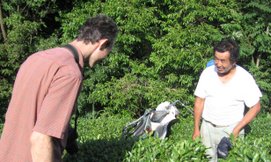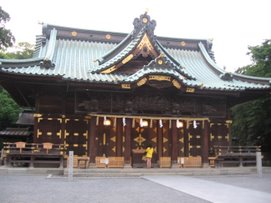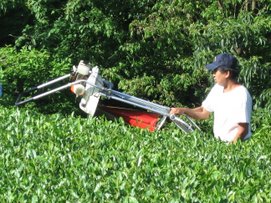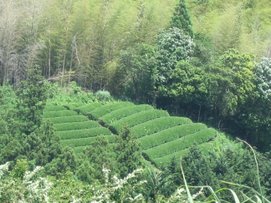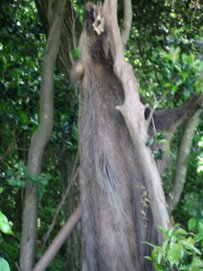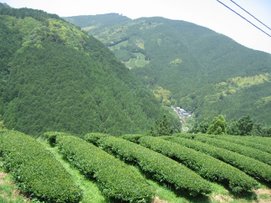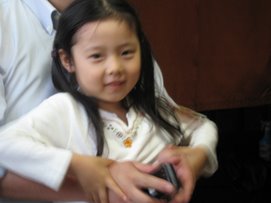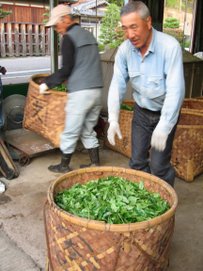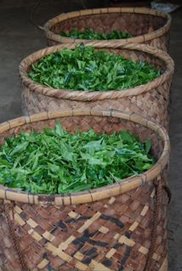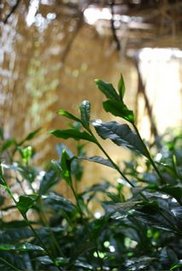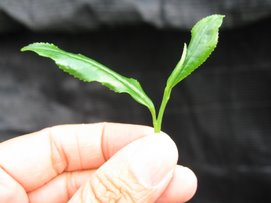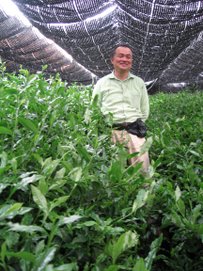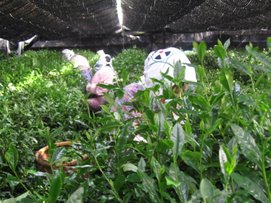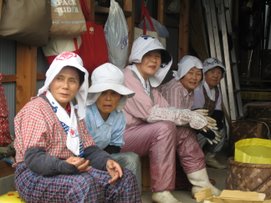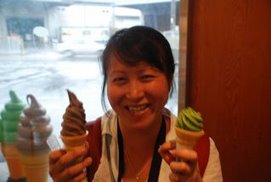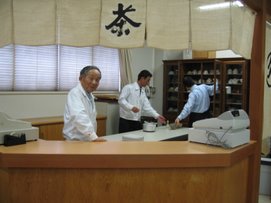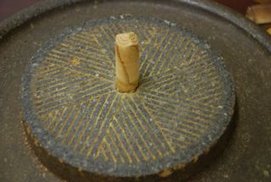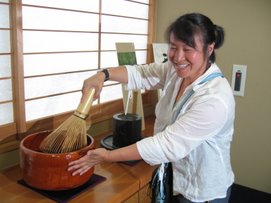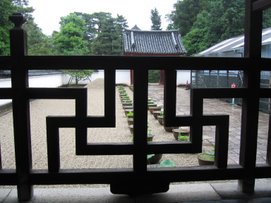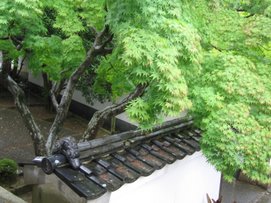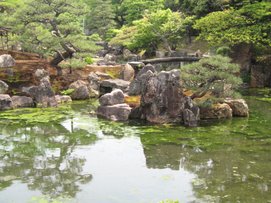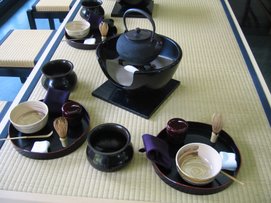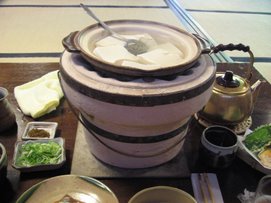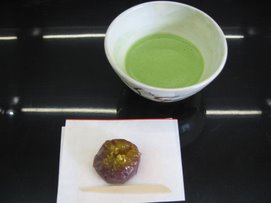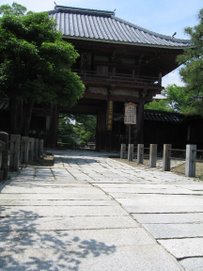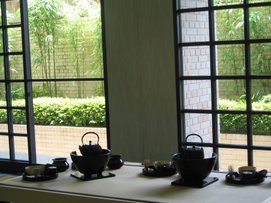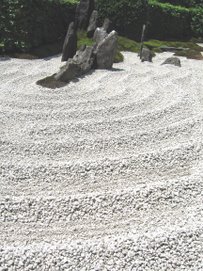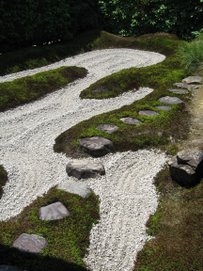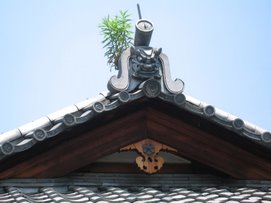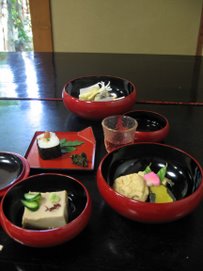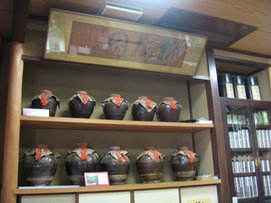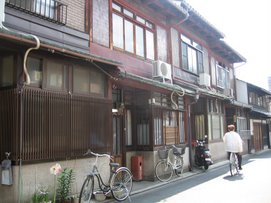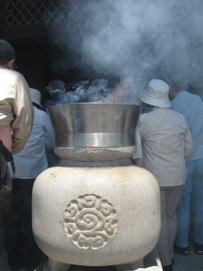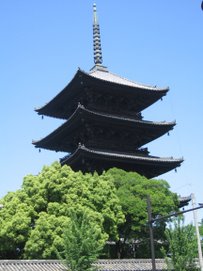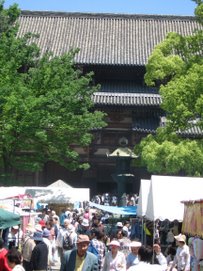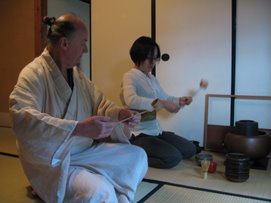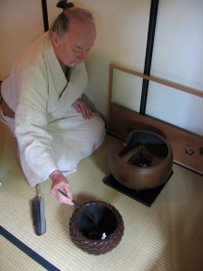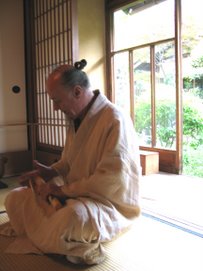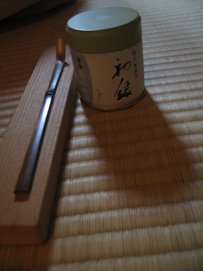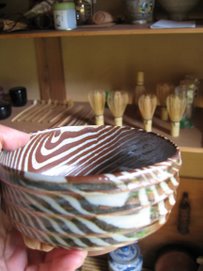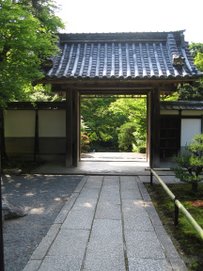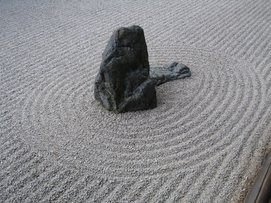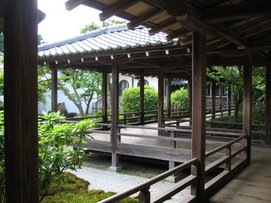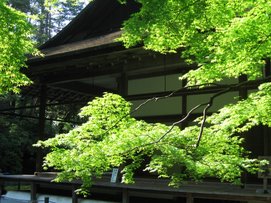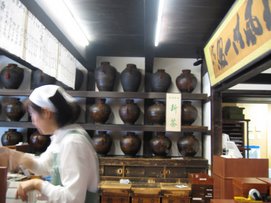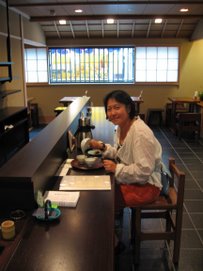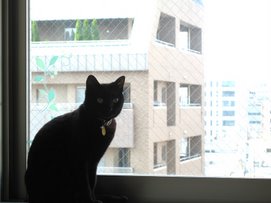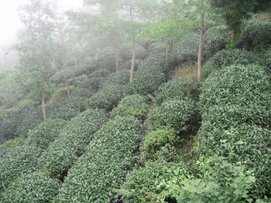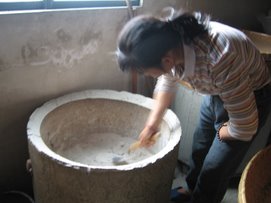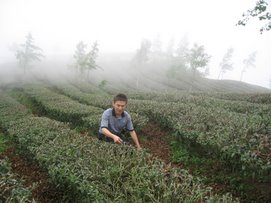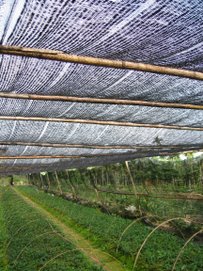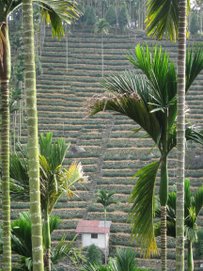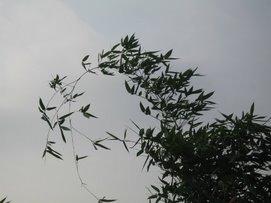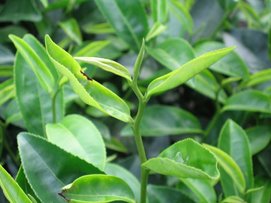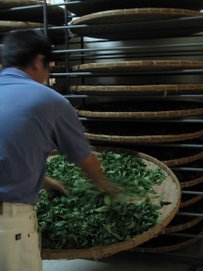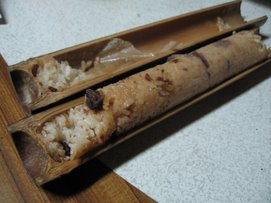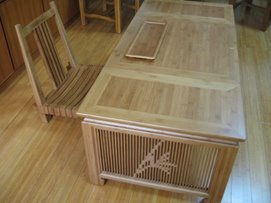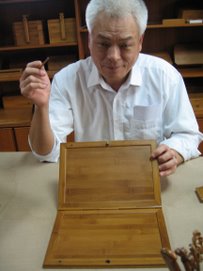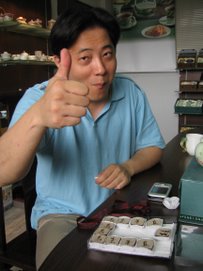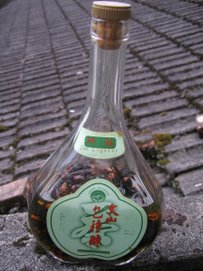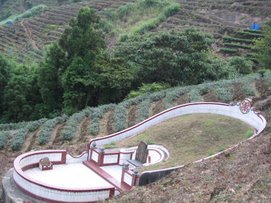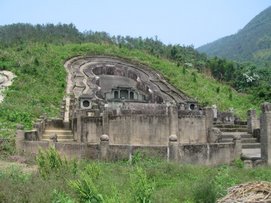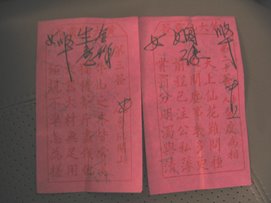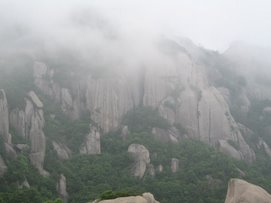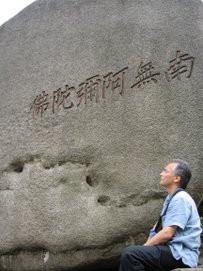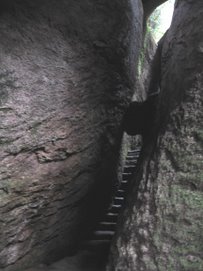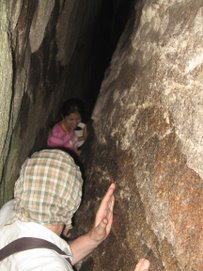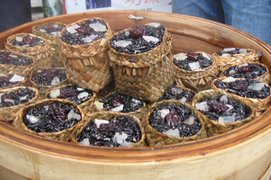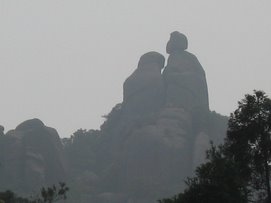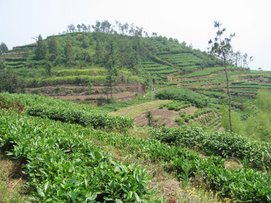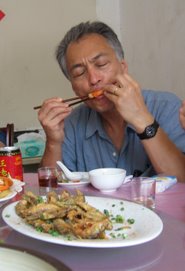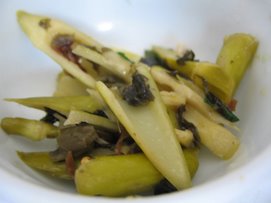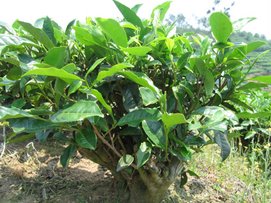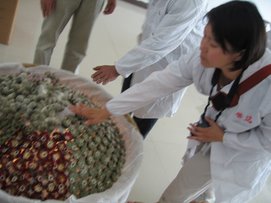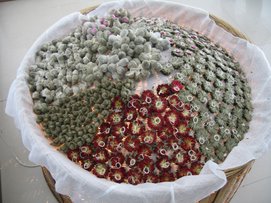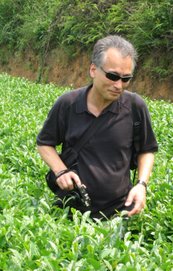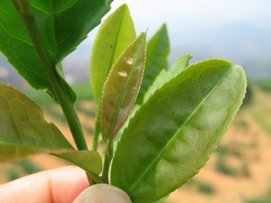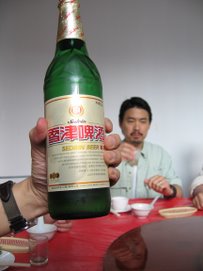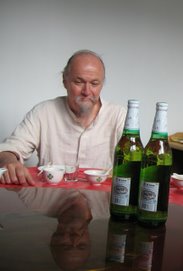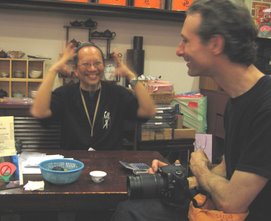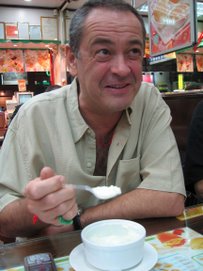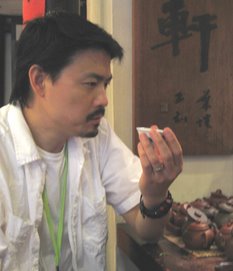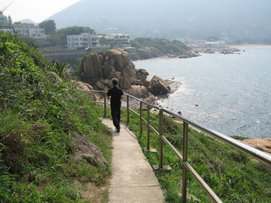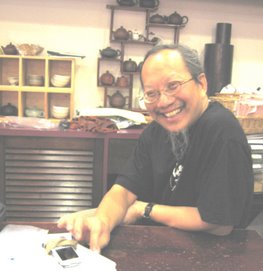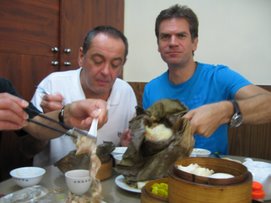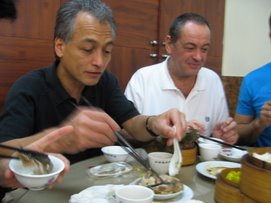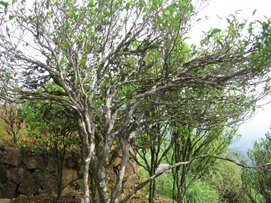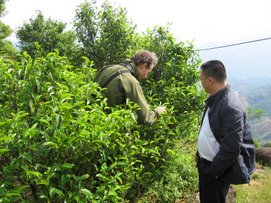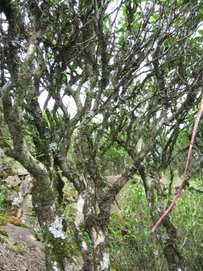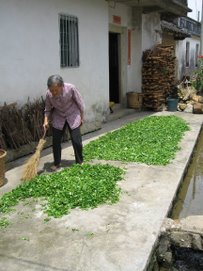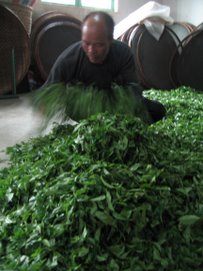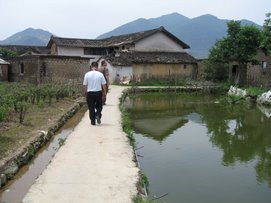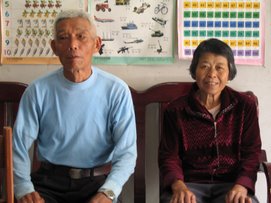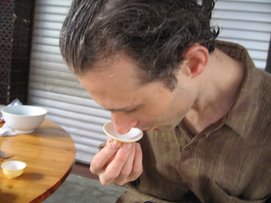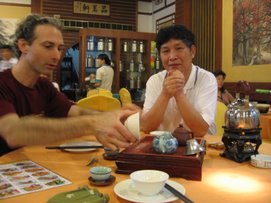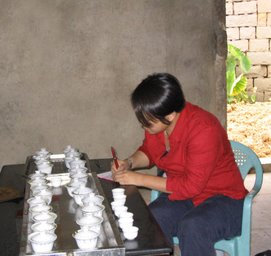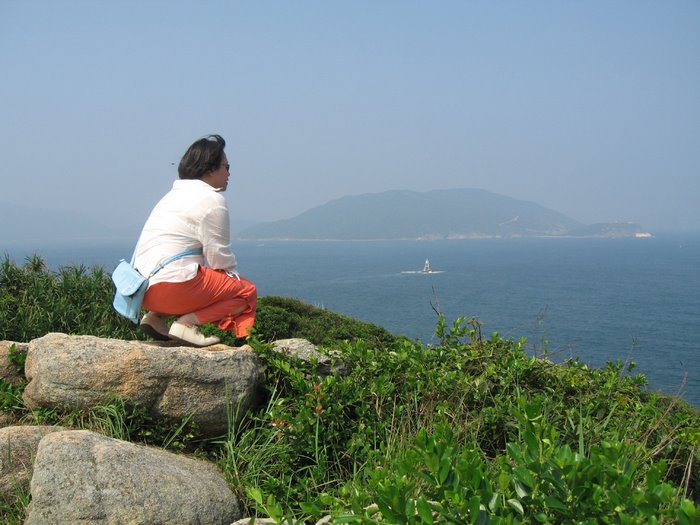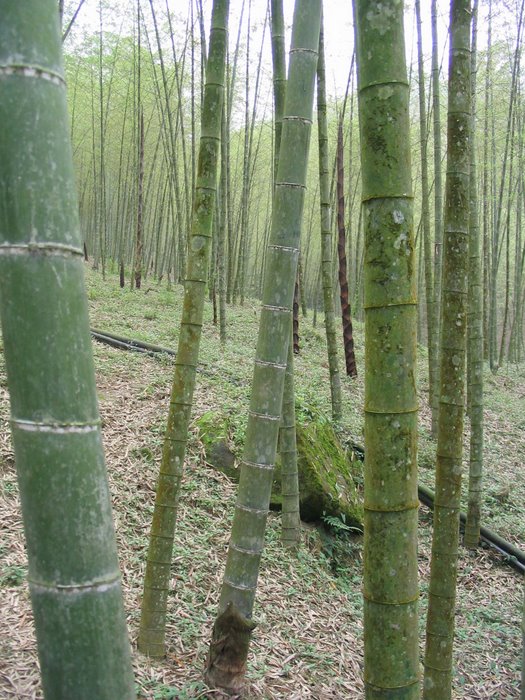In the evening after touring and learning about Mr. Saito's organic tea farm, Seb and I retired to Mishima, and walked around the only town in Japan where the hedges are not perfectly trimmed. The Bronx of Japan, I said. Nonetheless, the local Shinto Shrine was beautifully gilded golden and full of detailed carvings of nature. I left Seb to visit with his friends and returned on an almost 20 hour trip back to the U.S. It will be a long way to go before our customers can experience and appreciate all those wonderful teas from these unique, almost one of a kind craftspeople around Asia. But in any case, we travel endlessly to find them for everyone, so remember all of our blood, sweat, and tears (and forget all the good food we've had along the way)!!
I hope this explains why the teas are considered expensive. We are supporting innovative yet traditional farming techniques that do not strip the earth/sustainable, we are supporting small farmers whose pride and joy is their teas, we are supporting academics at research institutes who develop new varietals that are more disease and pest resistant, and most of all, we are searching for good people to make good tea. At the same time, we are building our community of like minded tea professionals and sharing and exchanging information, so that the public can enjoy better and better quality teas, in turn supporting tea professionals like ourselves. Thanks for reading!
Stone Basin
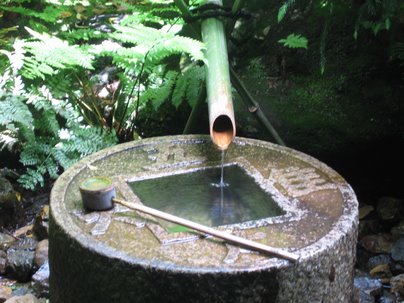
at Ryo An Jin
Monday, May 28, 2007
Last Day in Shizuoka
Got up early and took the bullet train to Shizuoka, about 2 hours away. The Shinkansen trains are so fast I am sure it's past the speed of sound. Sebastian and I just looked at each other and laughed hysterically. Our camcorders weren't fast enough to capture the train moving.
We were driven around by the head of the organic farmers' cooperative of which there are four farmers. There are each defined by a different terroir and source of water, which was of supreme importance. The farm we visited belonged to Mr. Saito, who has been growing tea for 37 years, and organic teas for 17. He is one of the pioneers that Slow Food Italy cited as an example of organic farming in Japan, which is certified by the JAS. Mr. Saito takes great care in re-fertilizing his fields using hay and other vegetation. What was fascinating to me though is the skin of the ino-shi-shi, a wild boar, put up as an example of boars who dared to ruin the fields again.
Mr. Saito has a moonshine room where he is experimenting with all kinds of fermented vegetables, including natto, for fertilization. He and his wife work their entire farm, and Mr. Hara, our translator, informed us that such tea craftspeople can not hope to survive in Japan without subsidy from the government, due to cheap Chinese tea imports.....
We were driven around by the head of the organic farmers' cooperative of which there are four farmers. There are each defined by a different terroir and source of water, which was of supreme importance. The farm we visited belonged to Mr. Saito, who has been growing tea for 37 years, and organic teas for 17. He is one of the pioneers that Slow Food Italy cited as an example of organic farming in Japan, which is certified by the JAS. Mr. Saito takes great care in re-fertilizing his fields using hay and other vegetation. What was fascinating to me though is the skin of the ino-shi-shi, a wild boar, put up as an example of boars who dared to ruin the fields again.
Mr. Saito has a moonshine room where he is experimenting with all kinds of fermented vegetables, including natto, for fertilization. He and his wife work their entire farm, and Mr. Hara, our translator, informed us that such tea craftspeople can not hope to survive in Japan without subsidy from the government, due to cheap Chinese tea imports.....
2 Days Before Last
Sebastian and I met up with Mr. Taniguchi who supplies us with some of the finest sencha and gyokuro in Uji. But first, we stopped at Ryo An Ji, one of the most famous Zen temples in Kyoto, mobbed by school kids and tourists. Nonetheless, the faultlessly perfect stone gardens and the moss carpetted gardens, not to mention the quintessential Japanese woodwork and beams made out of whole tree trunks, captivated Sebastian so much it was hard to leave. His father, apparently, had built quite a few Japanese teahouses in the East coast (www.superlativetea.com/category_s/26.htm) and Seb had some experience with the woodwork. His enthusiasm spilled over to me and we wandered around, bowled over by the experience.
Mr. Taniguchi made it a point to stop in at the farmer's cooperative teahouse first before going to the gardens. We must understand how to steep sencha and gyokuro the right way, or all the best leaves won't make a bit of difference. What was fascinating and new though was eating the fine gyokuro leaves as salad after steeping it 4 times. Add some ponzu sauce, which was yuzu/citrus vinegar plus soy sauce, and an incredibly delectible salad was served. Sencha was steeped at 50 degrees celsius, and Gyokuro was at 40 degrees.
The Gyokuro plantations were either traditionally shaded by hay, which required ALOT more work, but gave it a softer sunlight shading (90% of light shaded out), vs. the new black plastic tarp like overhangs. The obasans were picking tea when we arrived, chatting away like women tea pickers in China or Taiwan. They were all cute, short, and about 80 years old. Sebastian's head almost hit the tarp roof.
Onward to see lots of gyokuro processing and meet Mr. Shimooka, who has won more top awards for his teas than there are kanji. The machines were complicated and precise, but no matter. For Mr. Shimooka, it is the care he puts into feeding his plants. For example, for the Gyokuro tofu meal is used for fertilizer, and instead of using pesticide, they use bug pheromones, which makes males think they are supposed to be looking to mate with female bugs, not eating the leaves. Or something like that. And then they die shortly after their mating cycle, which doesn't actually happen.
The Uji teas have a very specific, local taste of soybeans. As Japan teas have all originated from Uji (Only 7 families own the right to grow tea in the past), its taste was the standard by which sencha and gyokuro was judged. These were the teas that lower classes were allowed to drink as matcha was reserved for the upper classes only.
Mr. Taniguchi made it a point to stop in at the farmer's cooperative teahouse first before going to the gardens. We must understand how to steep sencha and gyokuro the right way, or all the best leaves won't make a bit of difference. What was fascinating and new though was eating the fine gyokuro leaves as salad after steeping it 4 times. Add some ponzu sauce, which was yuzu/citrus vinegar plus soy sauce, and an incredibly delectible salad was served. Sencha was steeped at 50 degrees celsius, and Gyokuro was at 40 degrees.
The Gyokuro plantations were either traditionally shaded by hay, which required ALOT more work, but gave it a softer sunlight shading (90% of light shaded out), vs. the new black plastic tarp like overhangs. The obasans were picking tea when we arrived, chatting away like women tea pickers in China or Taiwan. They were all cute, short, and about 80 years old. Sebastian's head almost hit the tarp roof.
Onward to see lots of gyokuro processing and meet Mr. Shimooka, who has won more top awards for his teas than there are kanji. The machines were complicated and precise, but no matter. For Mr. Shimooka, it is the care he puts into feeding his plants. For example, for the Gyokuro tofu meal is used for fertilizer, and instead of using pesticide, they use bug pheromones, which makes males think they are supposed to be looking to mate with female bugs, not eating the leaves. Or something like that. And then they die shortly after their mating cycle, which doesn't actually happen.
The Uji teas have a very specific, local taste of soybeans. As Japan teas have all originated from Uji (Only 7 families own the right to grow tea in the past), its taste was the standard by which sencha and gyokuro was judged. These were the teas that lower classes were allowed to drink as matcha was reserved for the upper classes only.
Saturday, May 26, 2007
3 Days Before Last Day
Uji At Koyama En
Koyama En is one of the most highly regarded tea companies in Japan, specializing in matcha. They are not only award winning, they don't have enough supply to meet demand in Japan alone. We were told to sell more ice cream grade matcha. Sebastian and I looked at each other and thought, OK, who should we sell to, the local gelato shop? NO, we want good matcha! Alas, who appreciates good matcha in America? Better not embarrass ourselves.
Sebastian arrived from Bhutan, looking quite rested. The next day found ourselves thick in the pouring Uji rain, as we met Soren at the Manpukuji temple, founded by Chinese Zen monks who escaped the regime change in China and brought whole leaf teas to Japan with them in the Ching Dynasty. This started the consumption of tea in the lower classes in Japan, and later on, sencha was discovered.
Koyama En was started by two brothers, and now mainly run by two of the sons of one of the Mr. Koyamas. The older uncle is an expert in the stone milling of the matcha, and as a result, stays on, happily it seems, to consult and monitor whether the mills are cut correctly, modifications needed, etc. It was quite a long, meticulous and generous sharing of his expertise which neither the translator nor myself, for sure, was able to understand much. However, seeing a room full of 320 such mills processing about 40gms each hour was amazing, though their demand exceeds supply at this point. Matcha is at least a 600 year plus tradition but seeing it all mechanized and efficient (you know those Japanese....) was strangely moving. I know this doesn't sound like much of a post, but since Koyama En was kind enough to allow me to photograph and obtain information generally not available to the public, you will all have to wait until I get permission to post further information about their inner workings.....
The Hoji Cha Ice Cream was worth the entire trip to Japan, and I had some knock out food there. Maybe we'll stop selling tea and focus on tea i su ku-ri-mu....
Koyama En is one of the most highly regarded tea companies in Japan, specializing in matcha. They are not only award winning, they don't have enough supply to meet demand in Japan alone. We were told to sell more ice cream grade matcha. Sebastian and I looked at each other and thought, OK, who should we sell to, the local gelato shop? NO, we want good matcha! Alas, who appreciates good matcha in America? Better not embarrass ourselves.
Sebastian arrived from Bhutan, looking quite rested. The next day found ourselves thick in the pouring Uji rain, as we met Soren at the Manpukuji temple, founded by Chinese Zen monks who escaped the regime change in China and brought whole leaf teas to Japan with them in the Ching Dynasty. This started the consumption of tea in the lower classes in Japan, and later on, sencha was discovered.
Koyama En was started by two brothers, and now mainly run by two of the sons of one of the Mr. Koyamas. The older uncle is an expert in the stone milling of the matcha, and as a result, stays on, happily it seems, to consult and monitor whether the mills are cut correctly, modifications needed, etc. It was quite a long, meticulous and generous sharing of his expertise which neither the translator nor myself, for sure, was able to understand much. However, seeing a room full of 320 such mills processing about 40gms each hour was amazing, though their demand exceeds supply at this point. Matcha is at least a 600 year plus tradition but seeing it all mechanized and efficient (you know those Japanese....) was strangely moving. I know this doesn't sound like much of a post, but since Koyama En was kind enough to allow me to photograph and obtain information generally not available to the public, you will all have to wait until I get permission to post further information about their inner workings.....
The Hoji Cha Ice Cream was worth the entire trip to Japan, and I had some knock out food there. Maybe we'll stop selling tea and focus on tea i su ku-ri-mu....
Wednesday, May 23, 2007
Day 21 Nijo Castle
Last bit of tourism after some business, and the next few days will be at Uji tea farms. Whew! Ready to get out of the city.
Nijo Castle has by far the most tourists. Built in the 1600's by the first Tokugawa Shogun, it was the epitome of Shogunate power and the very halls and paintings reflect the hidden gleam of the swords. Or maybe I have just watched way too many samurai movies in my life, as well as historical epics about Ieyasu, Yoshinobu, etc. The flooring of the main halls where the feudal lords were received was called the nightingale walk, which meant that the floors creaked loudly on purpose, so even lightfooted ninjas can not sneak up without warning. Guess I shouldn't change out my squeaky wooden floors at home then. The palace had a moat, as palaces should, and even the garden lacked relaxation or glamour. Nijo Castle felt extremely functional and powerful, far from the floating world of Gion and Geishas, far from the serene Zen temple gardens. This was a place where they anticipated assasinations and katanas crossing at any moment, not the glamourous incense filled red and gold luxurious rooms of the Forbidden Palace in Beijing. The emperors there seem lazy compared to the Shoguns! Indeed, Kyoto, as an ancient capitol, feels classier and less snobby than Beijing. And stronger, less precarious, and for god's sake, it's not in a sand bowl next to the Great Wall! And they drink the very best tea in Japan, Uji Sencha, unlike Jasmine tea in Beijing. Have I already mentioned this part about Jasmine tea in Beijing? I thought I'd mention it again as it is unforgivable.
Nijo Castle has by far the most tourists. Built in the 1600's by the first Tokugawa Shogun, it was the epitome of Shogunate power and the very halls and paintings reflect the hidden gleam of the swords. Or maybe I have just watched way too many samurai movies in my life, as well as historical epics about Ieyasu, Yoshinobu, etc. The flooring of the main halls where the feudal lords were received was called the nightingale walk, which meant that the floors creaked loudly on purpose, so even lightfooted ninjas can not sneak up without warning. Guess I shouldn't change out my squeaky wooden floors at home then. The palace had a moat, as palaces should, and even the garden lacked relaxation or glamour. Nijo Castle felt extremely functional and powerful, far from the floating world of Gion and Geishas, far from the serene Zen temple gardens. This was a place where they anticipated assasinations and katanas crossing at any moment, not the glamourous incense filled red and gold luxurious rooms of the Forbidden Palace in Beijing. The emperors there seem lazy compared to the Shoguns! Indeed, Kyoto, as an ancient capitol, feels classier and less snobby than Beijing. And stronger, less precarious, and for god's sake, it's not in a sand bowl next to the Great Wall! And they drink the very best tea in Japan, Uji Sencha, unlike Jasmine tea in Beijing. Have I already mentioned this part about Jasmine tea in Beijing? I thought I'd mention it again as it is unforgivable.
Day 20 Urasenke
Urasenke, one of the two main schools of tea ceremony, or chanoyu, is located in the northern part of Kyoto, and there is a school and a museum in a temple area (but everywhere is temple area) surrounded by other Chanoyu type shops. Managed to find some great chawans. I didn't go inside the Urasenke school, because out came a line of perfectly made up young women in perfect kimono. There was something extremely scary about that sight, so I turned and ran. It brought back memories of sitting through chanoyu for an infernal amount of time, worse than the Bardo it seemed, while the hostesses, women with make up as thick as the brocade on their kimonos, appraised you with knitted brows should you even blink the wrong way.
I thought the matcha I had at Soren Sensei's place was brilliant, an extremely satisfying bowl, and an even more revelation, that chanoyu doesn't have to be long, or boring, or conducted by housewives.
Everywhere I went, if I kept the conversations very short, the shop owners do not catch on that I am not Nihonjin/Japanese. However, things fall apart when they ask me anything beyond if I want a bag with my purchase or is this a gift. They ask where I am from. I said the U.S., which is where I am FROM. But then they'll say, your face is Japanese or Chinese. So I'll say, the next time, I am Chinese. This produces some cold shoulders from the normally faultlessly polite Kyoto folks. One day, someone asked, China's big, where in China are you from? I then said, Hong Kong. Instantly, the man smiled, relaxed, and said, Hong Kong is not really China! It seems that the more close the ethnic groups are, the more they discriminate against each other. In some parts of the world, they are currently at war over it. Such nuanced parsing. I should just say I am from Berkeley-NY-Hong Kong-Hainan-Canton, in the sequence of where I have lived.
Did manage to go into the Urasenke museum, exhibiting some truly beautiful wabi sabi chawans and everything attendent. Even enjoyed a gold leafed mochi and some matcha on the house. Quickly took a picture of the classroom, where I can use to point out yet AGAIN that tetsubin cast iron pots are for HOTWATER (see how they sit on the burner) and not for making tea. This picture being from Urasenke headquarters, folks, I hope this is enough proof. Japanese green teas must be prepared at the exact temperatures in pottery, as they are even more fussy than China greens. The thought that Americans would pour boiling hot water into a cast iron teapot into a little metal basket of not enough tea leaves just churns our stomachs. I didn't tell the tea professionals in Kyoto about this part.
Enjoyed some really silky, ethereal yudofu for lunch. Tofu served either grilled, made with sesame, in hotwater served with sichimi, or as ground tofu soup. Delicious. I feel quite happy that at the very least, I eat extremely well here. At least one good meal a day. The rest are on the road at the 7 eleven, but the musubi are quite good enough.
I thought the matcha I had at Soren Sensei's place was brilliant, an extremely satisfying bowl, and an even more revelation, that chanoyu doesn't have to be long, or boring, or conducted by housewives.
Everywhere I went, if I kept the conversations very short, the shop owners do not catch on that I am not Nihonjin/Japanese. However, things fall apart when they ask me anything beyond if I want a bag with my purchase or is this a gift. They ask where I am from. I said the U.S., which is where I am FROM. But then they'll say, your face is Japanese or Chinese. So I'll say, the next time, I am Chinese. This produces some cold shoulders from the normally faultlessly polite Kyoto folks. One day, someone asked, China's big, where in China are you from? I then said, Hong Kong. Instantly, the man smiled, relaxed, and said, Hong Kong is not really China! It seems that the more close the ethnic groups are, the more they discriminate against each other. In some parts of the world, they are currently at war over it. Such nuanced parsing. I should just say I am from Berkeley-NY-Hong Kong-Hainan-Canton, in the sequence of where I have lived.
Did manage to go into the Urasenke museum, exhibiting some truly beautiful wabi sabi chawans and everything attendent. Even enjoyed a gold leafed mochi and some matcha on the house. Quickly took a picture of the classroom, where I can use to point out yet AGAIN that tetsubin cast iron pots are for HOTWATER (see how they sit on the burner) and not for making tea. This picture being from Urasenke headquarters, folks, I hope this is enough proof. Japanese green teas must be prepared at the exact temperatures in pottery, as they are even more fussy than China greens. The thought that Americans would pour boiling hot water into a cast iron teapot into a little metal basket of not enough tea leaves just churns our stomachs. I didn't tell the tea professionals in Kyoto about this part.
Enjoyed some really silky, ethereal yudofu for lunch. Tofu served either grilled, made with sesame, in hotwater served with sichimi, or as ground tofu soup. Delicious. I feel quite happy that at the very least, I eat extremely well here. At least one good meal a day. The rest are on the road at the 7 eleven, but the musubi are quite good enough.
Tuesday, May 22, 2007
Day 19 A Day in the Life
I am ready to leave Kyoto. It's really hard to stay at a place where everything is so perfect. It's perfect not in the way that Singapore is perfect, mind you. It's just perfect in the way I value things. If I stay longer, I might just live here permanently. To make matters worse, I feel perfectly comfortable with all aspects of life, from the transportation, to the streets and how they are laid out, to the way people are, to the food and tea, of course, which is of supreme importance. People even bike around, with cotton masks. There is virtually no pollution, though the tap water isn't great. There are Buddhist temples everywhere, old houses, little alleys, small stores, and craftsmen proudly specializing in their crafts for centuries. Now there are many Starbucks, but who cares, you can get Musubi Rice Balls at the 7 Eleven. I just lament the fact that I am unsuited to live outside of Asia. And I have had more wagashi and mochi to be decent. No, I can't bring myself to admit it quite yet. I will need a support group first.
Early in the morning, I headed out to Daitokuji, where I was asked to get some natto. I had always wanted to visit this temple anyway, and hopefully there will be fewer tourists. But Zuiho-in was mostly where I ended up, one of the sub monasteries with the most interesting sand garden ever. The coarse sand has been raked to reflect a turbulent ocean, the turbulent ocean of our minds. Even the rocks that represented the miniature mountains are odd, pointed, and jutting out in different directions, a garden of immense discord and disharmony, though at first sight, it sure looked Zen and serene. It was odd to sit and reflect at this particular garden, but effectively, it quieted my mind quickly somehow. Maybe it was the reminder that our minds are so busy and unnecessarily bumpy. Sometimes, as soon as you are present in the moment and reminded of where your state of mind is, it quickly dissipates.
But what was in store, even better than the Zen mind, is the Zen vegetarian temple food. The little teahouse restaurant on the temple grounds served kaiseki lunch, including a bowl of natto, yuba, tofu, wonderful soup, a variety of other dishes, and a bowl of matcha as well as plum wine. I made peace with the natto today. It will never show up on my top three foods to puke with again, namely, Durian, Stinky Tofu, and Salty Fish. After hanging out in Central Hong Kong in 100 degree weather and wafts of Salty Fish festering in the heat attacked me, it has definitely replaced natto, which, Kyoto style, is quite good!
The kaiseki lunch was beyond satisfying! Zen priests sure live a good life.
Ryuoen teashop proved to be quite impressive. Their Shin Cha just blew the lid off of Ippodo, making them look like a Starbucks. Of course, I make it my business to visit teashops everywhere in the world. But Ryuoen must be undemonstratively one of the best. And they made their teas at such perfect lukewarm temperatures. Everywhere I went, I just had to ask if anyone uses tetsubins for tea making. Most of them were shocked, some laughed as if I was joking, and then some solemnly informed me that it is FOR HOTWATER only. Americans, please take note of this fact, which I did not make up. No one in Japan uses tetsubin/iron teapots for making tea. But don't take my word for it. I went all over Kyoto asking all the local tea professionals for YOUR erudition, not mine.
Walked all the way in a very hot day to a very obscure little street for a very long time, just to get some tofu from Iriyama, an old tofu shop. So I cooked dinner, something I haven't done for over a year, just so I can enjoy this freshly made fried tofu. It was worth the blood, sweat, and tears. Well, just the sweat. I need to move this tofu shop to Berkeley.
Early in the morning, I headed out to Daitokuji, where I was asked to get some natto. I had always wanted to visit this temple anyway, and hopefully there will be fewer tourists. But Zuiho-in was mostly where I ended up, one of the sub monasteries with the most interesting sand garden ever. The coarse sand has been raked to reflect a turbulent ocean, the turbulent ocean of our minds. Even the rocks that represented the miniature mountains are odd, pointed, and jutting out in different directions, a garden of immense discord and disharmony, though at first sight, it sure looked Zen and serene. It was odd to sit and reflect at this particular garden, but effectively, it quieted my mind quickly somehow. Maybe it was the reminder that our minds are so busy and unnecessarily bumpy. Sometimes, as soon as you are present in the moment and reminded of where your state of mind is, it quickly dissipates.
But what was in store, even better than the Zen mind, is the Zen vegetarian temple food. The little teahouse restaurant on the temple grounds served kaiseki lunch, including a bowl of natto, yuba, tofu, wonderful soup, a variety of other dishes, and a bowl of matcha as well as plum wine. I made peace with the natto today. It will never show up on my top three foods to puke with again, namely, Durian, Stinky Tofu, and Salty Fish. After hanging out in Central Hong Kong in 100 degree weather and wafts of Salty Fish festering in the heat attacked me, it has definitely replaced natto, which, Kyoto style, is quite good!
The kaiseki lunch was beyond satisfying! Zen priests sure live a good life.
Ryuoen teashop proved to be quite impressive. Their Shin Cha just blew the lid off of Ippodo, making them look like a Starbucks. Of course, I make it my business to visit teashops everywhere in the world. But Ryuoen must be undemonstratively one of the best. And they made their teas at such perfect lukewarm temperatures. Everywhere I went, I just had to ask if anyone uses tetsubins for tea making. Most of them were shocked, some laughed as if I was joking, and then some solemnly informed me that it is FOR HOTWATER only. Americans, please take note of this fact, which I did not make up. No one in Japan uses tetsubin/iron teapots for making tea. But don't take my word for it. I went all over Kyoto asking all the local tea professionals for YOUR erudition, not mine.
Walked all the way in a very hot day to a very obscure little street for a very long time, just to get some tofu from Iriyama, an old tofu shop. So I cooked dinner, something I haven't done for over a year, just so I can enjoy this freshly made fried tofu. It was worth the blood, sweat, and tears. Well, just the sweat. I need to move this tofu shop to Berkeley.
Monday, May 21, 2007
Day 18 Toji and Ceramics
Today was one long day of shopping and attempting to bargain in my poor Japanese. My friend Takami accompanied me to Toji temple, the site of the monthly 'flea market' of antiques and all kinds of street vendors selling all kinds of wares. Fortunately there was an ice cream stand with a great Yuzu flavour, or Takami and I would have fainted. It was a hot, glaring sunny day, and the crowd was out in troves. For the first time, I felt tall. I could see above the crowd! Many senior citizens were out, especially, older Japanese women, and boy, I felt like a giant! Anyway, it was good not to speak too much Japanese, for as it turned out, I could be rude and bargain the vendors to the death. Takami was amazed at the prices I got, but it was not the bloody duels that a market in China, for example, would have generated.
Anyway, got a variety of antiques, including a furui Korean stone ware bowl of about 350 years old (discount it by at least half that number of years for true age) and a great chawan from the Meiji period, which is not really that long ago. So it was a good day.
Headed out to KiyoMizu Pottery district, where some of the earliest potters thrived and made wares for the throne. Kyoto is famous for so many arts and crafts. There are tofu shops, fan shops, indigo dye shops, wagashi sweet shops, silk, pottery, combs, baskets, and of course, tea shops, just to name a few. Kyoto is fabulous, where old and new meets seamlessly and the new does not seem to intrude into the flavor of its timeless identity. Everything is orderly and neat, people are polite and friendly, and hardly anything felt contrived or tacky. The only disquieting issue was that for such an immaculate city, there was a curious lack of public trash cans. Because of 9/11, Takami said. The city removed all the trash cans for fear of Al Qaida. There was as much chance of Al Qaida choosing Kyoto trash cans as choosing the Walmarts in Ohio, but one is allowed to dream....
Anyway, got a variety of antiques, including a furui Korean stone ware bowl of about 350 years old (discount it by at least half that number of years for true age) and a great chawan from the Meiji period, which is not really that long ago. So it was a good day.
Headed out to KiyoMizu Pottery district, where some of the earliest potters thrived and made wares for the throne. Kyoto is famous for so many arts and crafts. There are tofu shops, fan shops, indigo dye shops, wagashi sweet shops, silk, pottery, combs, baskets, and of course, tea shops, just to name a few. Kyoto is fabulous, where old and new meets seamlessly and the new does not seem to intrude into the flavor of its timeless identity. Everything is orderly and neat, people are polite and friendly, and hardly anything felt contrived or tacky. The only disquieting issue was that for such an immaculate city, there was a curious lack of public trash cans. Because of 9/11, Takami said. The city removed all the trash cans for fear of Al Qaida. There was as much chance of Al Qaida choosing Kyoto trash cans as choosing the Walmarts in Ohio, but one is allowed to dream....
Sunday, May 20, 2007
Day 17 Kyoto with Soren
Soren Bisgaard Sensei, yet another master from a different era. Spent the day at his beautifully restored old house in Northern Kyoto. First, I had to earn it. No one knew where his house was, even people who proved to live exactly 2 doors down. I walked around the neighborhood for a good hour before somehow finding it, after having inquired at the police station, old knick knack shop, about 10 passerbys, flower stall, and cab drivers. You would think any of these people would know their own neighborhood.
Soren was training a beginner student in tea ceremony when I arrived and I made him some Taiwanese oolong to mix things up a bit. There are actually two houses connected by a courtyard garden, and when his students arrived, they switched the tatamis to reflect the summer style of Chado vs. Winter, where the ofuro will now sit on top of the tatami.
Soren pulled out his latest creation, his prized tea scoop named 'hatsu enishi', or first affinity. Affinity in Buddhism is sort of like fate, where you meet someone and instantly you feel a connection on both sides. It could also be love at first sight. As a result, the tea scoop is yang on the bottom and yin on the top, curved vs. square, and dark bamboo on the bottom and light on top, all separated perfectly by the knot of the bamboo. Everything, you see, has such poetic meaning. Did you know that the yang hand is the left hand, asked Soren? I said I didn't know. He asked, 'do you know which direction the ancient Chinese emperors sat on their thrones?' I said sure, that's easy, they sit facing south, because the best feng shui is when you sit with your back to the north and face south. That means their left hand points to the east, which is where the sun rises, therefore making it yang, therefore making the left hand yang. Interesting isn't it? I thought it was at least. So the yang hand handles the yin chawan and the yin hand handles the urn full of tea, and full means yang. Anyways, ceremony helps us focus on a moving meditation. Use your entire body, not just your hands, Soren instructs his students. Otherwise your chi, or ki, or energy, collapses, and as a host you have invited your guests to receive an offering of tea, so if your energy collapses, then you are sucking energy, not giving! I said that is just like Tai Chi. In fact, Soren said, tea ceremony is a combination of Taoist, Buddhist, Confucian, Shinto, and even Christian philosophies!
The students tirelessly sat through about 5 hours of instruction. I had a great time observing, filming, and learning at least what some of the extensive nuances are. The flying arrow is the time when you practiced forever on something like archery, but at the moment you released your arrow in the air, you still don't know if it will hit the mark! So is like everything else in life.
Soren was training a beginner student in tea ceremony when I arrived and I made him some Taiwanese oolong to mix things up a bit. There are actually two houses connected by a courtyard garden, and when his students arrived, they switched the tatamis to reflect the summer style of Chado vs. Winter, where the ofuro will now sit on top of the tatami.
Soren pulled out his latest creation, his prized tea scoop named 'hatsu enishi', or first affinity. Affinity in Buddhism is sort of like fate, where you meet someone and instantly you feel a connection on both sides. It could also be love at first sight. As a result, the tea scoop is yang on the bottom and yin on the top, curved vs. square, and dark bamboo on the bottom and light on top, all separated perfectly by the knot of the bamboo. Everything, you see, has such poetic meaning. Did you know that the yang hand is the left hand, asked Soren? I said I didn't know. He asked, 'do you know which direction the ancient Chinese emperors sat on their thrones?' I said sure, that's easy, they sit facing south, because the best feng shui is when you sit with your back to the north and face south. That means their left hand points to the east, which is where the sun rises, therefore making it yang, therefore making the left hand yang. Interesting isn't it? I thought it was at least. So the yang hand handles the yin chawan and the yin hand handles the urn full of tea, and full means yang. Anyways, ceremony helps us focus on a moving meditation. Use your entire body, not just your hands, Soren instructs his students. Otherwise your chi, or ki, or energy, collapses, and as a host you have invited your guests to receive an offering of tea, so if your energy collapses, then you are sucking energy, not giving! I said that is just like Tai Chi. In fact, Soren said, tea ceremony is a combination of Taoist, Buddhist, Confucian, Shinto, and even Christian philosophies!
The students tirelessly sat through about 5 hours of instruction. I had a great time observing, filming, and learning at least what some of the extensive nuances are. The flying arrow is the time when you practiced forever on something like archery, but at the moment you released your arrow in the air, you still don't know if it will hit the mark! So is like everything else in life.
Saturday, May 19, 2007
Day 16 Kyoto
If I am not careful, I can end up moving to Kyoto. Japan's expensive? Compare it to the Bay Area and it will instantly feel economical. The food is better, much better, and the sweets are to die for. Uji makes the best teas in Japan. Everything is squeaky clean, the service level is extreme, and all the toilets are at my height and heated/self cleaning. Not to mention the charm of old Kyoto as in no where in the world. My friend Takami lives here and teaches Buddhism at Otani University. He lives on the 10th floor of a beautiful building with two beautiful cats, who long to leap from the 10th to the 1st floor if allowed. Outside the huge windows is a surrounding veranda that completely filters out any street noise. Not that Kyoto is noisy. I just came back from Hong Kong and Taipei for god's sake.
I decided to indulge alittle today and do the tourist stuff. Of course that involves visiting Ippodo, one of the oldest and most prestigious teahouses in Japan. 'Tis the season for Sincha (New Sencha) and there are signs everywhere for tastings. I stopped in in the frizzy morning rain, a comfortable 60 degrees F or so, no pollution, and quite busy already with some seemingly very serious tea buyers in the shop. The waitress struggled with the Eigo a bit and I struggled with my Nihongo. Haven't really had the occasion to speak it for years, and what comes out now isn't in sentences any longer. The waitress meticulously made sure that I knew how to steep my Shincha, proper temperature at 60 degrees C, at 30 seconds, and served with a ridiculously delicious warabi mochi. I've already had freshly made pastries with red beans this morning, but there's never enough pastry to be had in Kyoto, is there?
The Shincha was delicious, dewey and grassy, with that signature Uji creaminess.
Lunch at an old Soba shop, fresh green tea soba with daikon mush, plus lots of sweets along the way. I have lost count. Nihonjin desu ga? iiee, Chyugoku Jin desu, iiee, Amerika jin desu, whatever.....
Visited Nanzenji, one of the landmark Buddhist Temples of Kyoto. I believe I have been to all of them during one of the pilgrimages, but it's always good to reconnect. This time however, there was a pervasive sense of disconnect to Buddhism. There were many tourists, and the grounds are still immaculate and perfectly naturally ornate. The sand is still in perfect circles. But you can hardly see any of the Buddhist statues and altars in the interior rooms, and the spiritual majesty I felt lurking seems to be dissipating somehow. Is it me maybe? Quite depressed, I went home to go drinking with my friend Takami, the heaviest drinker I know who is also a dedicated Buddhist.
I decided to indulge alittle today and do the tourist stuff. Of course that involves visiting Ippodo, one of the oldest and most prestigious teahouses in Japan. 'Tis the season for Sincha (New Sencha) and there are signs everywhere for tastings. I stopped in in the frizzy morning rain, a comfortable 60 degrees F or so, no pollution, and quite busy already with some seemingly very serious tea buyers in the shop. The waitress struggled with the Eigo a bit and I struggled with my Nihongo. Haven't really had the occasion to speak it for years, and what comes out now isn't in sentences any longer. The waitress meticulously made sure that I knew how to steep my Shincha, proper temperature at 60 degrees C, at 30 seconds, and served with a ridiculously delicious warabi mochi. I've already had freshly made pastries with red beans this morning, but there's never enough pastry to be had in Kyoto, is there?
The Shincha was delicious, dewey and grassy, with that signature Uji creaminess.
Lunch at an old Soba shop, fresh green tea soba with daikon mush, plus lots of sweets along the way. I have lost count. Nihonjin desu ga? iiee, Chyugoku Jin desu, iiee, Amerika jin desu, whatever.....
Visited Nanzenji, one of the landmark Buddhist Temples of Kyoto. I believe I have been to all of them during one of the pilgrimages, but it's always good to reconnect. This time however, there was a pervasive sense of disconnect to Buddhism. There were many tourists, and the grounds are still immaculate and perfectly naturally ornate. The sand is still in perfect circles. But you can hardly see any of the Buddhist statues and altars in the interior rooms, and the spiritual majesty I felt lurking seems to be dissipating somehow. Is it me maybe? Quite depressed, I went home to go drinking with my friend Takami, the heaviest drinker I know who is also a dedicated Buddhist.
Thursday, May 17, 2007
Day 14 Nantou and Taichung
Long day. Stayed up almost all night processing tea, but standing around and learning the nuances is mostly what I did, not that I actually contributed to expediting the process. I stayed up with the farmers for their amusement more than anything else I think. In any case, I learned to identify the amount of churning the primary drying needs in terms of what the steam smells like (acidity still present? Fruity aroma or floral? acrid or charred?) and the sound of the falling leaves hitting the bottom of the dryer. All by experience of course, but improperly dried leaves will hit the bottom with a wet thud instead of a tinkling jewel like sound. Anyway, I will have about 5 lbs. of this Winnie processed Jin Shuan for everyone to taste in a while. I am not sure they are going to be able to sell it anyway, even though this batch was meant for the competition. The weather was perfect that day and they had decided this was the batch, especially the noon batch, which was perfectly sun dried. It would be with supreme irony if it actually won the competition given that I was unable to do most things, like stick myself into the 100 degree roaster and grab the leaves and smell them.
Watched the charcoal fire roasting at the Tung Ting farmer's house, which is Mrs. So my friend, a supermom and one of the few good woman tea craftsman. The charcoal comes from longan trees, and the temperature is also around 100 celsius. The charcoal roasted oolong has always been one of our most prized oolongs that we love.
Headed up amidst dense fog to San Lin She, the High Mountain of about 1600 meters where we pick up our High Mountain Oolong. Didn't fall off any cliffs, but the breathtaking bamboo forest was quite a sight. Taiwan is known for its bamboos, amongst other things, and Meng Zhong Jhu, a large whitish green tall stalk graces everything from charcoal for cooking to tea scoops to furniture.
Off to Taichung, met up with Gene my friend from the States who has been travelling around for months now to learn about his roots. We had a nice convo about what it means to be uniquely Chinese as well as American, but not Chinese American, as it is hard to fit in either culture, and as a result, can fit into both. Of course, not fitting in is fine with me. That means I have an incentive to never settle down and keep moving!
A special thanks to my cousin, who drives me around patiently all around Taiwan mountains in search of teas and farmers. Actually, alot of them are his friends, and meeting the new ones with me seems to be just as much fun for him. He drinks beer and smokes a couple of packs to cheer me on while I processed tea all night.
Watched the charcoal fire roasting at the Tung Ting farmer's house, which is Mrs. So my friend, a supermom and one of the few good woman tea craftsman. The charcoal comes from longan trees, and the temperature is also around 100 celsius. The charcoal roasted oolong has always been one of our most prized oolongs that we love.
Headed up amidst dense fog to San Lin She, the High Mountain of about 1600 meters where we pick up our High Mountain Oolong. Didn't fall off any cliffs, but the breathtaking bamboo forest was quite a sight. Taiwan is known for its bamboos, amongst other things, and Meng Zhong Jhu, a large whitish green tall stalk graces everything from charcoal for cooking to tea scoops to furniture.
Off to Taichung, met up with Gene my friend from the States who has been travelling around for months now to learn about his roots. We had a nice convo about what it means to be uniquely Chinese as well as American, but not Chinese American, as it is hard to fit in either culture, and as a result, can fit into both. Of course, not fitting in is fine with me. That means I have an incentive to never settle down and keep moving!
A special thanks to my cousin, who drives me around patiently all around Taiwan mountains in search of teas and farmers. Actually, alot of them are his friends, and meeting the new ones with me seems to be just as much fun for him. He drinks beer and smokes a couple of packs to cheer me on while I processed tea all night.
Wednesday, May 16, 2007
Day 13 Nantou
Mr. Bamboola has a head of white hair, a glowing red face, and one of the last bastions of the Chinese puzzle locks. Excitedly he shows off his latest invention, a menu box that no customer in the world can open. Ancient Chinese locks were famous for their ingenuity and challenge, and no keys are required except your intelligence. Mr. Bamboola has not only preserved this dying art, but also, made advances, contributing to his complete head of white hair. No matter. I was far from able to open most of the boxes, but I was there to find some new beautiful bamboo teawares. Exceptionally expensive, meticulously fitted, and breathtakingly beautiful, they have a natural yet polished look, functional and ingenuous. Most of the bamboo walls at the teashop at Teance are from Mr. Bamboola courtesy of his partners at PlyBoo USA, and we are testaments to their longlasting and natural beauty. I broke down and got one of those puzzle menu boxes, as I will try to frustrate my partner Mr. Cheng with it when I return.
What a genius Mr. Bamboola was, a character again from another era. What did he major in college? He replied, animal husbandry. So you see, there are exceptions to everything in life.
Mr. Liu , tea judge and expert tea maker, Nantou, Taiwan.
Mr. Liu talks a mile a minute, cutting between Mandarin, Taiwanese, and some very local slang no one understands the entymology of. However, his expertise and knowledge is formidable, as he has served as tea judge for over 10 years, and his dedication to the perfection of his teas is extreme. For example, his Four Seasons and Jin Shuan Oolongs are naturally organic. He explains the reasons for the fact that they are organic, and they are far from commercial reasons.
His hillsides are meticulously trimmed and neat, and some small bug bites are visible everywhere on the leaves. However, the tea aphids are welcome as they eat the bitter juices off of the leaves, leaving the sweet juices. Therefore, although not every leaf will be perfect looking, nonetheless, the leaves will be very sweet. Therefore, to achieve this sweetness, Mr. Liu never applies pesticide. He explains further that the organic fertilizers he uses are pulp soybeans and pulp potatoes. These natural fertilizers take about 2 weeks to break down in the soil, and the tea plants will absorb it slowly, and it takes 6 weeks to turn around another pickable harvest. Chemical fertilizers take 2 days! For people in the business of tea, the slowness of natural fertilizers make no sense. Mr. Liu is in the ‘Conscience Business’, he says. Tea making is his pride and joy, and being a tea judge, he is not about to lose face at the competition.
His wife makes the bamboo rice, sticks of Taiwanese bamboo stuffed with rice and wild mushrooms and then steamed. I usually eat enough to burst, and then eat some more. I plan to stay up all night to help Mr. Liu process teas because she promised she would steam some more bamboo rice for me in case I worked up a hunger.
What a genius Mr. Bamboola was, a character again from another era. What did he major in college? He replied, animal husbandry. So you see, there are exceptions to everything in life.
Mr. Liu , tea judge and expert tea maker, Nantou, Taiwan.
Mr. Liu talks a mile a minute, cutting between Mandarin, Taiwanese, and some very local slang no one understands the entymology of. However, his expertise and knowledge is formidable, as he has served as tea judge for over 10 years, and his dedication to the perfection of his teas is extreme. For example, his Four Seasons and Jin Shuan Oolongs are naturally organic. He explains the reasons for the fact that they are organic, and they are far from commercial reasons.
His hillsides are meticulously trimmed and neat, and some small bug bites are visible everywhere on the leaves. However, the tea aphids are welcome as they eat the bitter juices off of the leaves, leaving the sweet juices. Therefore, although not every leaf will be perfect looking, nonetheless, the leaves will be very sweet. Therefore, to achieve this sweetness, Mr. Liu never applies pesticide. He explains further that the organic fertilizers he uses are pulp soybeans and pulp potatoes. These natural fertilizers take about 2 weeks to break down in the soil, and the tea plants will absorb it slowly, and it takes 6 weeks to turn around another pickable harvest. Chemical fertilizers take 2 days! For people in the business of tea, the slowness of natural fertilizers make no sense. Mr. Liu is in the ‘Conscience Business’, he says. Tea making is his pride and joy, and being a tea judge, he is not about to lose face at the competition.
His wife makes the bamboo rice, sticks of Taiwanese bamboo stuffed with rice and wild mushrooms and then steamed. I usually eat enough to burst, and then eat some more. I plan to stay up all night to help Mr. Liu process teas because she promised she would steam some more bamboo rice for me in case I worked up a hunger.
Tuesday, May 15, 2007
Day 12 Taipei
Hurried out of the airport to the pottery district to do my purchasing. Our friends at Eilong were rather busy today, but this is a remarkable family. 5 brothers and sisters, the parents started the company, and each sibling is adept at a different function. Some design, some market, some operate the business. 2 kilns, 3 warehouses, worldwide distribution. Very, very nice people. I had Mr. Chen, the middle brother, try the Charles Chocolates Tea Chocolates (almost totally melted from the heat), and he swallowed 4 in a row. He was absolutely amazed at how good they were and the fact that he could taste the different teas. I was going to reserve judgement until my friends in Asia try them, you know? They are not into chocolate but are particular about tea. This made me feel quite relieved. Of course he was extra polite since both oolong flavors were made from Taiwan oolongs, and one was Baochong, his native tea.
Rushed over to Wenshan to see Mr. Lee our Baochong farmer. He's nervous. The tea competition is in 3 days and hopefully, he'll win at least silver this year, though one year he won the gold and drank himself to a stupor in celebration. You see the farmers here eat lots of beetlenut but don't drink alot of alcohol. He showed me proudly a bottle of giant bumblebee sorghum wine. Not really for drinking, he says. It's used for the bee stings that occur daily so the wine gives them resistance and builds up tolerance. Baochong is one of the most fragrant teas in the world, but other fragrances graced our walk around the hills: giant bushes of wild gardenias and osmanthus. Of course, the ancestral tomb was also right there on the hillside. It's rather touching that they are all buried with their beloved tea. In Fuding, Tano and I saw tomb after tomb amidst the tea terraces, a very moving sight indeed.
Sitting at the 24 hour bookstore in Taipei. Tomorrow: Taichung.
Hurried out of the airport to the pottery district to do my purchasing. Our friends at Eilong were rather busy today, but this is a remarkable family. 5 brothers and sisters, the parents started the company, and each sibling is adept at a different function. Some design, some market, some operate the business. 2 kilns, 3 warehouses, worldwide distribution. Very, very nice people. I had Mr. Chen, the middle brother, try the Charles Chocolates Tea Chocolates (almost totally melted from the heat), and he swallowed 4 in a row. He was absolutely amazed at how good they were and the fact that he could taste the different teas. I was going to reserve judgement until my friends in Asia try them, you know? They are not into chocolate but are particular about tea. This made me feel quite relieved. Of course he was extra polite since both oolong flavors were made from Taiwan oolongs, and one was Baochong, his native tea.
Rushed over to Wenshan to see Mr. Lee our Baochong farmer. He's nervous. The tea competition is in 3 days and hopefully, he'll win at least silver this year, though one year he won the gold and drank himself to a stupor in celebration. You see the farmers here eat lots of beetlenut but don't drink alot of alcohol. He showed me proudly a bottle of giant bumblebee sorghum wine. Not really for drinking, he says. It's used for the bee stings that occur daily so the wine gives them resistance and builds up tolerance. Baochong is one of the most fragrant teas in the world, but other fragrances graced our walk around the hills: giant bushes of wild gardenias and osmanthus. Of course, the ancestral tomb was also right there on the hillside. It's rather touching that they are all buried with their beloved tea. In Fuding, Tano and I saw tomb after tomb amidst the tea terraces, a very moving sight indeed.
Sitting at the 24 hour bookstore in Taipei. Tomorrow: Taichung.
Day 12 Early Morning Philosophy
Early morning, I bid goodbye to Hong Kong, and just in time too. The heat, the crowd, and the suffocating pollution is getting to me. On top of it, it’s time for me to move on to a place with fewer people I know, so there is less politics. Politics will kill all the joy in life. Anytime you have a few Asians together there is politics. Anytime you place a few people together anywhere in the world, even, I suspect, a Buddhist monastery, there will be politics. Rather than looking into ourselves and growing as people, we resort to cruelty and violence, and this manifests big and small, everywhere in every relationship. This is how you know bad karma perpetuates. Everywhere you go, there you are. I personally love Hong Kong, because the crowds are so huge, I can disappear seamlessly and enjoy life without people, because there are so many that I am insulated from exposure. There are so many people, I don’t have to talk to anyone at all, and hence, possibly, a respite from politics. Are there real friendships in life? Maybe not, just food stall after restaurant, camera and mobile phone store after cosmetic store after shoe store after McDonalds. Yes, the McDonalds in Hong Kong are now 24 hours. I can now junk food myself to death anywhere in the world, not just the U.S. Off to Taiwan, where the economy is awful and people are depressed. The suicide rate is particularly high. Hopefully this beautiful island is exempt from the cruel typhoons this year, as one year I showed up to the 13th one in a row and many farmers have lost everything and ended up jumping to their deaths in the raging avalanches of water.
Monday, May 14, 2007
Day 11 HK
Tano's off to Singapore for the Buddhist Film Festival, an admirable feat anywhere in the world. Check it out at ibff.org
Seb's off to India and Bhutan, his second home. Regrettably, I am unable to go with him. I thought about the yaks and the tea bushes Seb planted years ago. Up on those elevations, the plants must be doing well, waiting for some tea masters to roll in and have them processed as Bhutanese High Mountain Oolong. As someone from Nepal once said, 'our mountains are at least 12,000 feet...'
But I will be off to Taiwan tomorrow where the mountains are 800 mi, or around 1500 feet.
The colorful cast of characters have disbursed.
Today was a normal day in HK, running around shopping, what Hong Kong people do best. But I did make a stop at my godfather Wong Dai Shin's temple, an ancient Taoist master whose immortal body was enshrouded in gold leaf because it never rotted from its sitting meditation position. The people of Hong Kong go ask for advice in the form of wooden sticks that pop out amongst a can full of about 60 other sticks for a reading or prophecy. Masters sit around the temple to read your stick for you, which are numbered. I lived near this temple as a child and was adopted as the Taoist Master's goddaughter. Don't ask me how that could happen as he's been dead for over 500 years. In any case, his readings for me has always been dead accurate. Each time I am in HK, and have extra time, I always pay him a visit, and if I have the nerve to want to know my future, I will pray for a stick reading.
This year was one of those years. The readings this time were strange in their specificity. I will leave it for some of us to read. But I can't reveal its contents here.
Seb's off to India and Bhutan, his second home. Regrettably, I am unable to go with him. I thought about the yaks and the tea bushes Seb planted years ago. Up on those elevations, the plants must be doing well, waiting for some tea masters to roll in and have them processed as Bhutanese High Mountain Oolong. As someone from Nepal once said, 'our mountains are at least 12,000 feet...'
But I will be off to Taiwan tomorrow where the mountains are 800 mi, or around 1500 feet.
The colorful cast of characters have disbursed.
Today was a normal day in HK, running around shopping, what Hong Kong people do best. But I did make a stop at my godfather Wong Dai Shin's temple, an ancient Taoist master whose immortal body was enshrouded in gold leaf because it never rotted from its sitting meditation position. The people of Hong Kong go ask for advice in the form of wooden sticks that pop out amongst a can full of about 60 other sticks for a reading or prophecy. Masters sit around the temple to read your stick for you, which are numbered. I lived near this temple as a child and was adopted as the Taoist Master's goddaughter. Don't ask me how that could happen as he's been dead for over 500 years. In any case, his readings for me has always been dead accurate. Each time I am in HK, and have extra time, I always pay him a visit, and if I have the nerve to want to know my future, I will pray for a stick reading.
This year was one of those years. The readings this time were strange in their specificity. I will leave it for some of us to read. But I can't reveal its contents here.
Sunday, May 13, 2007
Day 9 the Quest for Black Rice
Mt Tai Mu was named some time ago after a woman who cured her kids of measles with the local white tea, therefore somehow, making it famous, so the locals worshipped her, especially the She people, a local indigenous group, famous for their Black Rice.
Strange shaped rocks jut unbelievably and often, vertically at 800 meters above sea, overlooking the ocean. Each couple of paces brought a new vista, some strange rock formation that looked like a turtle, an elephant, a cat springing on a mouse, etc. The strangest one though was called ‘Husband and Wife’. It looked eerily like a man looking up to the sky as his wife leaned on his shoulder, a vision both romantic and timeless. Did this couple turn into a rock one day while stargazing because the mountain was so beautiful and they simply forgot to go home? I would imagine it to happen to me, and someday, maybe it will, when I find my meditation rock deep in the mountains.
The mountains had a majestic quality, with those unlikely bare boulders shrouded by fog, contrasting with what were inside these rocks, the dark, mysterious caves one can easily disappear into. But everyone had fun with exploring the caves. Some were completely pitch dark, some had one slit above head called’ one glimmer sky’ , many were so narrow we were told we must suck our stomachs in and crouch while doing push ups against the walls to cross. All the cave rock surfaces were slippery and plastered with moss. The air inside the caves were chilly and sweet. At times, it was very claustrophobic as we don’t know whether we can be trapped. What if we had too much lunch and we couldn’t flatten our stomachs enough?
By the time we got to the base of the mountain they were almost done serving the Black Rice. Sitting in large steamers in each individual grass baskets, the black rice was sticky, naturally sweet, with a red date and fruit on top. Tano took one bite, and almost lost his mind. Both Soren and he agreed with me finally, that the Black Rice was by far, the best rice they ever had, and Winnie’ s right, it was absolutely worth the climb and the spelunking in the caves, to have this prize at the end!
Strange shaped rocks jut unbelievably and often, vertically at 800 meters above sea, overlooking the ocean. Each couple of paces brought a new vista, some strange rock formation that looked like a turtle, an elephant, a cat springing on a mouse, etc. The strangest one though was called ‘Husband and Wife’. It looked eerily like a man looking up to the sky as his wife leaned on his shoulder, a vision both romantic and timeless. Did this couple turn into a rock one day while stargazing because the mountain was so beautiful and they simply forgot to go home? I would imagine it to happen to me, and someday, maybe it will, when I find my meditation rock deep in the mountains.
The mountains had a majestic quality, with those unlikely bare boulders shrouded by fog, contrasting with what were inside these rocks, the dark, mysterious caves one can easily disappear into. But everyone had fun with exploring the caves. Some were completely pitch dark, some had one slit above head called’ one glimmer sky’ , many were so narrow we were told we must suck our stomachs in and crouch while doing push ups against the walls to cross. All the cave rock surfaces were slippery and plastered with moss. The air inside the caves were chilly and sweet. At times, it was very claustrophobic as we don’t know whether we can be trapped. What if we had too much lunch and we couldn’t flatten our stomachs enough?
By the time we got to the base of the mountain they were almost done serving the Black Rice. Sitting in large steamers in each individual grass baskets, the black rice was sticky, naturally sweet, with a red date and fruit on top. Tano took one bite, and almost lost his mind. Both Soren and he agreed with me finally, that the Black Rice was by far, the best rice they ever had, and Winnie’ s right, it was absolutely worth the climb and the spelunking in the caves, to have this prize at the end!
Day 9 1/2
The day started early with a drive to the tea farm at 600 meters or so. The farm is mostly organic, occupying some old and some newly acquired hills. These farmers are entrepreunerial and therefore, have become a systematized big enterprise, one of the largest in Fuding. First we checked out the white tea drying facility, a fascinating blend of the use of old and new technology. A coal burning stove blows hot air into a large room circulated by fans at the other end. In between are racks and racks of white tea leaves. The temperature is controlled at 35 degrees Celsius, and the hot air is blown through the wall through small square openings. That’s all the processing there is to White Tea! We sampled some of the ones made a couple of days ago and it was the freshest, brightest, most soothing tea with the longest wonderful aftertaste. We were quite happy to sit and drink tea all day long, but the day was getting on, and we hiked out into the mountain to see the bushes. Some major cuttings have taken place where the bushes were cut and burned down to almost root. But in a couple of months, bonsai like, the leaves will sprout out again, and in a couple of years, new growth will be available for harvesting.
It takes 10 lbs. of leaves to make 2.5 lbs. of dried leaves. It takes someone all day to harvest by hand, around 5-6 lbs. of leaf tips. It is painstaking and costly to pick white tea, especially organic white tea where the growth is slow and sparse. It is highly unlikely that authentic, Fuding white teas picked by hand, end up in your Snapple bottled drink regardless of what the commercial says.
It takes 10 lbs. of leaves to make 2.5 lbs. of dried leaves. It takes someone all day to harvest by hand, around 5-6 lbs. of leaf tips. It is painstaking and costly to pick white tea, especially organic white tea where the growth is slow and sparse. It is highly unlikely that authentic, Fuding white teas picked by hand, end up in your Snapple bottled drink regardless of what the commercial says.
Friday, May 11, 2007
Day 8 Fuding
Day 8
Soren, Aya, and Tano rode the 2 hours with me to Fuding. They must have low expectations, because they were happy to arrive!
We are staying in a four star hotel with clean bathrooms and great service.
The White Tea company we buy from are owned both by farmers who are also entrepreneurs. They are not only organically certified by EU standards, they also have the cleanest facility in China, period. Even Soren the European was somewhat impressed. My mission is to make sure that my Free Leaves are being made properly. It was good to see rows and rows of women tying these beautiful bouquets of fresh green and white tea leaves, wearing lab coats, gloves, and hair nets. We in fact, had to put on lab coats to get in, so that was fun for everyone, even Tano.
The agitating machines roll and separate the green teas. Their tea production factory is ISO 9000 certified, which means that the inspections are sudden, unannounced, and swift.
Hearing that foreigners of some sort were in town, the local TV station followed us around and interviewed me. If no one was run over by a truck nor the typhoon wasn’t too bad, then presumably we will be on the evening news.The banquet was outrageous on many levels. First of all, the head of the Agriculture Dept., an old professor type who was extremely organized in thought and ability to describe all proud aspects of life in Fuding, graced us with his presence at dinner, and pontificated on the natural resources present. First of all, the tea. White Down and Large White are the prime varietals of China, and originates from Fuding. It has the best health properties, and their motto is, ‘health, environment, and green foods’ Tano thought the beer was great. Indeed, it was light, but ahead of even TsingTao in taste. Then the dishes kept coming. Tano’s favorite was a brown bao filled with shrimp and some local farm raised fish. I had cold thin sliced bitter melon dipped in honey, and the most flavourful, sweetest local organic mushroom soup. Everything was well presented, unique, and perfectly balanced and tasty. You see, the politicians, the business people, and the local labour force are all on the same page: prosperity through a sustainable environment, green and clean food. Tano asked if Fuding was interested in having Berkeley as a sister city. I suspect it’s so he can come here often to eat. Both he and Soren could not stop eating nor praising this as the best meal they ever had in China.
Well, indeed, the city of Fuding was blessed with mountains as well as great spring water, and it is an ocean port city. Green crab, small river shrimp, just to name a few, are stable local foods feeding about 600,000 people, of which 320,000 people are involved in some aspect of tea.
Soren, Aya, and Tano rode the 2 hours with me to Fuding. They must have low expectations, because they were happy to arrive!
We are staying in a four star hotel with clean bathrooms and great service.
The White Tea company we buy from are owned both by farmers who are also entrepreneurs. They are not only organically certified by EU standards, they also have the cleanest facility in China, period. Even Soren the European was somewhat impressed. My mission is to make sure that my Free Leaves are being made properly. It was good to see rows and rows of women tying these beautiful bouquets of fresh green and white tea leaves, wearing lab coats, gloves, and hair nets. We in fact, had to put on lab coats to get in, so that was fun for everyone, even Tano.
The agitating machines roll and separate the green teas. Their tea production factory is ISO 9000 certified, which means that the inspections are sudden, unannounced, and swift.
Hearing that foreigners of some sort were in town, the local TV station followed us around and interviewed me. If no one was run over by a truck nor the typhoon wasn’t too bad, then presumably we will be on the evening news.The banquet was outrageous on many levels. First of all, the head of the Agriculture Dept., an old professor type who was extremely organized in thought and ability to describe all proud aspects of life in Fuding, graced us with his presence at dinner, and pontificated on the natural resources present. First of all, the tea. White Down and Large White are the prime varietals of China, and originates from Fuding. It has the best health properties, and their motto is, ‘health, environment, and green foods’ Tano thought the beer was great. Indeed, it was light, but ahead of even TsingTao in taste. Then the dishes kept coming. Tano’s favorite was a brown bao filled with shrimp and some local farm raised fish. I had cold thin sliced bitter melon dipped in honey, and the most flavourful, sweetest local organic mushroom soup. Everything was well presented, unique, and perfectly balanced and tasty. You see, the politicians, the business people, and the local labour force are all on the same page: prosperity through a sustainable environment, green and clean food. Tano asked if Fuding was interested in having Berkeley as a sister city. I suspect it’s so he can come here often to eat. Both he and Soren could not stop eating nor praising this as the best meal they ever had in China.
Well, indeed, the city of Fuding was blessed with mountains as well as great spring water, and it is an ocean port city. Green crab, small river shrimp, just to name a few, are stable local foods feeding about 600,000 people, of which 320,000 people are involved in some aspect of tea.
Thursday, May 10, 2007
Day 7 Secret Operation
Action packed day. First, we ended up at the oldest and most authoritative tea research facility, founded in 1935, and one of the founders at 98 years old, is still alive. After perusing the history and impressive collections of award winning new varietals they have developed, we headed up to the Collection Garden.
There are between 800 to 1000 new and old varietals in this tea garden, ranging from THE lone surviving Big Red Robe grafted from the original tree grown at the cliffs of Wuyi, and Fu-Yun, the Fujian Yunnan hybrid equally good for white tea or Pu-Erh as it is both! Outrageous! The garden was gloriously fragrant and the songbirds led the way. If you were remotely into tea, you have just discovered your heaven paved with streets of gold....leaves.
We then tasted through about 50 to 60 teas, acting as guinea pigs as some of these new varietals have never, ever, been tasted by any human being. I exaggerate. Human beings they let out of research institutes. Yes, these are rare species of humans here. Imagine, real tea experts, as opposed to quacks calling themselves 'tea experts' who require that you serve scones with white gloves when you serve tea.....
Gold Guanyin. Yellow Guanyin. Dan Gui. Nine Dragon Robe (delicious! I will have some for the connoisseurs at Teance), Fu Yun #5 made as a white, oolong or black...but eventually, they will all be made into Pu-Erh.
We learned alot, saw alot, tasted alot of teas, and made some business headway (won't discuss the business parts here). Suffice to say, I think we all got what we expected to. Tomorrow...off to Fu Ding!
There are between 800 to 1000 new and old varietals in this tea garden, ranging from THE lone surviving Big Red Robe grafted from the original tree grown at the cliffs of Wuyi, and Fu-Yun, the Fujian Yunnan hybrid equally good for white tea or Pu-Erh as it is both! Outrageous! The garden was gloriously fragrant and the songbirds led the way. If you were remotely into tea, you have just discovered your heaven paved with streets of gold....leaves.
We then tasted through about 50 to 60 teas, acting as guinea pigs as some of these new varietals have never, ever, been tasted by any human being. I exaggerate. Human beings they let out of research institutes. Yes, these are rare species of humans here. Imagine, real tea experts, as opposed to quacks calling themselves 'tea experts' who require that you serve scones with white gloves when you serve tea.....
Gold Guanyin. Yellow Guanyin. Dan Gui. Nine Dragon Robe (delicious! I will have some for the connoisseurs at Teance), Fu Yun #5 made as a white, oolong or black...but eventually, they will all be made into Pu-Erh.
We learned alot, saw alot, tasted alot of teas, and made some business headway (won't discuss the business parts here). Suffice to say, I think we all got what we expected to. Tomorrow...off to Fu Ding!
Politically corrected Day
Our intrepid group travelled to a secret area in Fujian to do something secret.
Well, actually, we are mostly there to check out the collection at the tea garden, what new varietals are being developed, and what some of the potentials are in terms of furthering the world of tea in a constructive manner. Our group was joined by Soren the Dane, who is a Japanese tea master, and his daughter. It was an interesting addition, as it must have been a culture shock for him. I was very curious to learn what Frank thought of Fujian as it is extremely similar to Taiwan in blood, land, and attitude. Frank is from Taiwan. He enjoyed the food so much that the title of Mr. In Pursuit might end up as his in the future, even though Sebastian is the seasoned traveller and you can plod him down anywhere in the world and he can adapt. Our day consisted of arriving, dusting ourselves off, and learning that Sebastian's name is in fact Si Bai Jin, which means 400 lbs. We thought it was hilarious but evidently he seemed ambivalent. Herein lies the difficulty of long English names. They were relieved that Frank is Mr. Kwei, or Osmanthus, in Chinese.
Indeed, it was a pleasure to travel with such a distinguished and knowledgeable group, all like minded and passionate about tea. The Tea Fanatics Anonymous. The guys at IN Pursuit of Tea are indeed, some of the best purveyors of all manners of teas to the public, worthy and respected colleagues who are there to survey and assess the possiblities of working with new varietals. Of course, in the back of my mind, and in my heart, I know that I have yet to steer people away from Vanilla Chai Roobois Medley. But no matter. At least for the next few days, we are among some of the most qualified tea academics in the world, and I would not feel so strange for a little while.
Well, actually, we are mostly there to check out the collection at the tea garden, what new varietals are being developed, and what some of the potentials are in terms of furthering the world of tea in a constructive manner. Our group was joined by Soren the Dane, who is a Japanese tea master, and his daughter. It was an interesting addition, as it must have been a culture shock for him. I was very curious to learn what Frank thought of Fujian as it is extremely similar to Taiwan in blood, land, and attitude. Frank is from Taiwan. He enjoyed the food so much that the title of Mr. In Pursuit might end up as his in the future, even though Sebastian is the seasoned traveller and you can plod him down anywhere in the world and he can adapt. Our day consisted of arriving, dusting ourselves off, and learning that Sebastian's name is in fact Si Bai Jin, which means 400 lbs. We thought it was hilarious but evidently he seemed ambivalent. Herein lies the difficulty of long English names. They were relieved that Frank is Mr. Kwei, or Osmanthus, in Chinese.
Indeed, it was a pleasure to travel with such a distinguished and knowledgeable group, all like minded and passionate about tea. The Tea Fanatics Anonymous. The guys at IN Pursuit of Tea are indeed, some of the best purveyors of all manners of teas to the public, worthy and respected colleagues who are there to survey and assess the possiblities of working with new varietals. Of course, in the back of my mind, and in my heart, I know that I have yet to steer people away from Vanilla Chai Roobois Medley. But no matter. At least for the next few days, we are among some of the most qualified tea academics in the world, and I would not feel so strange for a little while.
Tuesday, May 8, 2007
Day 6 Hong Kong, and with THE GROUP
The group traveling with me consists of Tano, Sebastian, Frank, Nicki, and Steffan. Not bad, you would think. Travelling with more than one person means a group. Travelling with a group means it takes 30 minutes to leave the curb to cross the street.
Surviving Hong Kong heat means carrying a miniature fan at all times while mopping your face with a handkerchief, ducking into any shop every few paces where there is AC, and, or, eating ice cream constantly. I opted for the ice cream although after THE GROUP laughed at me a few too many times, I am just mopping my face.
Late in the morning, I arrived at the madhouse called the Lotus Teahouse/Dim Sum Parlour, an institution in Hong Kong, run by very old, very grouchy, old timer Cantonese. However, they do serve some of the better restaurant Pu Erh in town with proper gaiwans, and the food is good typical Cantonese fare, which Seb defines as ‘pork or chicken’. Frank has arrived the night before and is intelligently keeping a low profile. I told him I only eat dessert, and he didn’t believe me. The only food options available for me were steamed lotus custard filled buns and chestnut cakes, which was perfect. Poor Seb just took pictures.
The day was unplanned, which means we get to wander around Hong Kong as Frank has never been. We headed out to Shek O, a hidden beach front resort village area for ‘other’ ethnic Chinese or nationals like Vietnamese, or Filipinos, or Ex Pats, or new trendy Americans. One would think this is anywhere in the world but Hong Kong. But many of us forget that HK is in fact, an island, a tropical one at that. The only difference is people are not slow island folks, it usually doesn’t take 3 hours to eat lunch, and palm trees…what palm trees? And who has time to sit at the beach anyways?
Back at Wing Chi’s for tea. This time, we are keen to have him judge the Phoenix teas we brought back. Wing Chi is unique and uniquely what you would expect as a character from another era, but perhaps, only in a movie or a book. He is bubbly, happy, has the best little wispy white Chinese beard, sort of longish hair tied back in a pony tail, practices and teaches calligraphy, master of tea, has two beautiful teahouses (one of which serves vegetarian dim sum made by nuns), and is a dignitary of sorts for the tea world. Frank and I dissected the Phoenix teas with WC one by one. WC deemed the almond flavour a winner and the Song 2nd generation a little under roasted, which was true as they rushed these samples out to me. This year’s green teas though, are all alittle tepid and unremarkable. We mourned a bit and decided at least, we have great oolongs. I am holding out for the Lu Shan Clouds and Mist crop though…
Dinner was chicken, very good chicken, which I didn’t eat. Seb and I had Carlsberg beer, about 5 bottles of it, and some vegetables.
Dessert was mango tapioca. Nicki tried the egg custard Hasmar, which WC explained was frog ovaries. You would think Nicki would be grossed out, but he ordered it immediately, and slurped it down with enjoyment to our chagrin. Second dessert was at a pub back near Central, and it served the most falling down scrumptious hot chocolate fudge cake paired with dark chocolate gelato. Tano talked non stop with Steffan so we decided to order a Sicilian wine to off balance things a bit , but it turned out to be excellent. A couple bottles later, we decided that the next 5 days will be work, so perhaps, third dessert and more booze might be too much…..
Surviving Hong Kong heat means carrying a miniature fan at all times while mopping your face with a handkerchief, ducking into any shop every few paces where there is AC, and, or, eating ice cream constantly. I opted for the ice cream although after THE GROUP laughed at me a few too many times, I am just mopping my face.
Late in the morning, I arrived at the madhouse called the Lotus Teahouse/Dim Sum Parlour, an institution in Hong Kong, run by very old, very grouchy, old timer Cantonese. However, they do serve some of the better restaurant Pu Erh in town with proper gaiwans, and the food is good typical Cantonese fare, which Seb defines as ‘pork or chicken’. Frank has arrived the night before and is intelligently keeping a low profile. I told him I only eat dessert, and he didn’t believe me. The only food options available for me were steamed lotus custard filled buns and chestnut cakes, which was perfect. Poor Seb just took pictures.
The day was unplanned, which means we get to wander around Hong Kong as Frank has never been. We headed out to Shek O, a hidden beach front resort village area for ‘other’ ethnic Chinese or nationals like Vietnamese, or Filipinos, or Ex Pats, or new trendy Americans. One would think this is anywhere in the world but Hong Kong. But many of us forget that HK is in fact, an island, a tropical one at that. The only difference is people are not slow island folks, it usually doesn’t take 3 hours to eat lunch, and palm trees…what palm trees? And who has time to sit at the beach anyways?
Back at Wing Chi’s for tea. This time, we are keen to have him judge the Phoenix teas we brought back. Wing Chi is unique and uniquely what you would expect as a character from another era, but perhaps, only in a movie or a book. He is bubbly, happy, has the best little wispy white Chinese beard, sort of longish hair tied back in a pony tail, practices and teaches calligraphy, master of tea, has two beautiful teahouses (one of which serves vegetarian dim sum made by nuns), and is a dignitary of sorts for the tea world. Frank and I dissected the Phoenix teas with WC one by one. WC deemed the almond flavour a winner and the Song 2nd generation a little under roasted, which was true as they rushed these samples out to me. This year’s green teas though, are all alittle tepid and unremarkable. We mourned a bit and decided at least, we have great oolongs. I am holding out for the Lu Shan Clouds and Mist crop though…
Dinner was chicken, very good chicken, which I didn’t eat. Seb and I had Carlsberg beer, about 5 bottles of it, and some vegetables.
Dessert was mango tapioca. Nicki tried the egg custard Hasmar, which WC explained was frog ovaries. You would think Nicki would be grossed out, but he ordered it immediately, and slurped it down with enjoyment to our chagrin. Second dessert was at a pub back near Central, and it served the most falling down scrumptious hot chocolate fudge cake paired with dark chocolate gelato. Tano talked non stop with Steffan so we decided to order a Sicilian wine to off balance things a bit , but it turned out to be excellent. A couple bottles later, we decided that the next 5 days will be work, so perhaps, third dessert and more booze might be too much…..
Monday, May 7, 2007
Day 5 HK, Tano, and Teashops
Tano arrives, on time, energetic, talking a mile a second, and of course, hungry. I scooped him into one of the trillion dim sum parlours in Sheung Wan and ordered his favorites, the Har Gau(shrimp dumplings), the Cheung Fan (rice rolls), and Shanghai Shao Long Bao with crab. By the time Seb arrived to join us, we had cleared through about 20 selections. I thought it was time. Next, I ordered the fish maw and fish head with brains. Since they have to rely on me to order in Cantonese, I thought I would take the opportunity to test what stuff Tano was made of. When the fish heads arrived, Tano didn't bat a lash, took a bite of the fish cheeks, and almost died and went to heaven. He ate the entire fish cheeks and brains and maybe even the eyeballs. Seb ordered some noodles.
Back at Wing Chi's shop for some tea afterwards to wait for Nicki. Nicki is Austrian and lives in Thailand, and his friend Steffan of Teegarten joined us for the day. Nicki rolls in, a giant with a huge smile. He pulls out his travel case of Himalayan salt and chilli peppers. We laughed and marveled but who are we to do that? We each have our own miniature travel gaiwan and cup set, not to mention Seb actually lugged, his metal can with the Phoenix oolong stash we just bought, all over town just so we can taste the freshest tea possible wherever.
Off to Mug Ngan Gey for noodles, the best Cantonese thin egg noodles on the planet. Served in relatively small bowls so not to get soggy, the texture was just al dente and slightly rubbery, and if you leave it in your soup for a couple seconds too late, it will be ruined! Tano says the problem is, you will never get it as good again, so in a way, it's a bad thing to experience. Well, whatever. I show up at this noodle shop each time I am in HK without fail. There is never this much consistency in life.
Back at Wing Chi's shop for some tea afterwards to wait for Nicki. Nicki is Austrian and lives in Thailand, and his friend Steffan of Teegarten joined us for the day. Nicki rolls in, a giant with a huge smile. He pulls out his travel case of Himalayan salt and chilli peppers. We laughed and marveled but who are we to do that? We each have our own miniature travel gaiwan and cup set, not to mention Seb actually lugged, his metal can with the Phoenix oolong stash we just bought, all over town just so we can taste the freshest tea possible wherever.
Off to Mug Ngan Gey for noodles, the best Cantonese thin egg noodles on the planet. Served in relatively small bowls so not to get soggy, the texture was just al dente and slightly rubbery, and if you leave it in your soup for a couple seconds too late, it will be ruined! Tano says the problem is, you will never get it as good again, so in a way, it's a bad thing to experience. Well, whatever. I show up at this noodle shop each time I am in HK without fail. There is never this much consistency in life.
Sunday, May 6, 2007
Day 3 and 4 Shantou and Phoenix Mtn.
Phoenix Mountain has some of the most esoteric oolong teas in the world, and it is little known just how great, how rare, or how strange, these teas are. Everyone’s perhaps heard of how old the trees and how teas of a lone, identifiable fragrance are picked from single groves. But just how many fragrances exist, and who gets to drink them? Sebastian and I were extremely lucky this time. It has been raining a difficult few days and the roads were treacherous, but we managed up the mountain under clear skies and anyway, didn’t even lose Seb in the meandering wild mountain groves of twisted old tea trees. The trees have lichen on the bark and the first Song Dynasty tree is well over 400 years old, so they seem rather pleased with their knarly twisted character. There are about 8 or so more common fragrances and about 6 single tree ones. By single tree, that means only one tree produces that fragrance, period. There is a particular one called ‘Ginger Flower’. The farmer who owned that tree sold his total crop of 3 kgs last year for (Yuan)20,000 RMBs, about $2,500 USD. He didn’t work for the rest of the year I am sure No Americans have been here since that other one, the farmers said, and even he hasn’t been seen in a couple of years. I explained David Lee Hoffman’s retirement and newly found stardom. Anyway, here is Sebastian, they can make him the new poster boy. Kids run out in the streets to wave at him, and the women peek and giggle from the doorway. The people in Shantou(town at the base of Phoenix), home of the Chau Chou gong fu tea tradition, are laid back and friendly, and drink more tea than any other town in China, with a probable correspondingly lowest rate of cancer. And they only drink good teas. Not that Jasmine stuff they drink in stuffy old Beijing. I never got the kind of reception Seb got but then they have always adopted me as a good Shantou citizen, being able to match tea capacity with the best of them!
The tallest peak is 1300 meters, and the best varietals and fragrances are from Wu Dong Mtn.(Black East). The only export company in town sells the low valley stuff they barely called Phoenix Mtn. to overseas French or Americans, and we suspect, Peet's. Anyway, I wouldn't dream of anywhere but Wu Dong as it is so cold bugs never survive and no pesticides are used. The fragrances we got to try this time ranged from Yellow Orchid Branch, 8 Immortals (What do Immortals smell like anyways, asked Seb?) , and one called ‘the East is Red’ named after Chairman Mao declared it his favorite. It is actually the Song Dynasty Second Generation tree of approximately 100 years old. I have, in my possession, some samples....... I know everyone is really excited, but those samples may not make its way back to the US, as our friend Tano is arriving tomorrow, and a tea this good will disappear in 3 minutes between the 3 of us. . My staff calls our regular Phoenix Honey fragrance Oolong ‘Crack’ Dan Chong, as they are massively addicted to it. No matter. I fell in love with a rare one this year called ‘Almond’. I can probably get about 10 kgs this year, of which the staff will probably hoard about 8 kgs. Teance customers, get in line! The villages are immaculate, the water cold and fresh and sweet, and no other industry exists except this business of tea. No wonder new plantings were ubiquitous as demand far exceeded supply. Few Phoenix Mtn. teas ever leave the local area, Mr. Lin, our farmer confides. But they are no good until at least 10 years old, even though most oolong bushes in other areas are good to pick by the time they are 3 years. Seb asked Mr. Lin how long he’s been doing tea. Mr. Lin says it’s hard to remember anymore, since the family at Phoenix has always done tea, and it’s close to a thousand years!The local food was the prized Phoenix tofu. It’s the water, they said. Soft, with a charred soy smell, and usually deep fried for a crunchy exterior. Otherwise it was lots of bitter mountain vegetables and some weird looking snail clams, which made Sebastian blanche yet again. We made the 5 hour bus ride back to HK, and I am beat. Tomorrow: entertain the tea VIPS who are congregating! My job? Take them to dim sum, what else?
The tallest peak is 1300 meters, and the best varietals and fragrances are from Wu Dong Mtn.(Black East). The only export company in town sells the low valley stuff they barely called Phoenix Mtn. to overseas French or Americans, and we suspect, Peet's. Anyway, I wouldn't dream of anywhere but Wu Dong as it is so cold bugs never survive and no pesticides are used. The fragrances we got to try this time ranged from Yellow Orchid Branch, 8 Immortals (What do Immortals smell like anyways, asked Seb?) , and one called ‘the East is Red’ named after Chairman Mao declared it his favorite. It is actually the Song Dynasty Second Generation tree of approximately 100 years old. I have, in my possession, some samples....... I know everyone is really excited, but those samples may not make its way back to the US, as our friend Tano is arriving tomorrow, and a tea this good will disappear in 3 minutes between the 3 of us. . My staff calls our regular Phoenix Honey fragrance Oolong ‘Crack’ Dan Chong, as they are massively addicted to it. No matter. I fell in love with a rare one this year called ‘Almond’. I can probably get about 10 kgs this year, of which the staff will probably hoard about 8 kgs. Teance customers, get in line! The villages are immaculate, the water cold and fresh and sweet, and no other industry exists except this business of tea. No wonder new plantings were ubiquitous as demand far exceeded supply. Few Phoenix Mtn. teas ever leave the local area, Mr. Lin, our farmer confides. But they are no good until at least 10 years old, even though most oolong bushes in other areas are good to pick by the time they are 3 years. Seb asked Mr. Lin how long he’s been doing tea. Mr. Lin says it’s hard to remember anymore, since the family at Phoenix has always done tea, and it’s close to a thousand years!The local food was the prized Phoenix tofu. It’s the water, they said. Soft, with a charred soy smell, and usually deep fried for a crunchy exterior. Otherwise it was lots of bitter mountain vegetables and some weird looking snail clams, which made Sebastian blanche yet again. We made the 5 hour bus ride back to HK, and I am beat. Tomorrow: entertain the tea VIPS who are congregating! My job? Take them to dim sum, what else?
Friday, May 4, 2007
Day 2 and 3 Canton
Early in the morning, before it was civilized for dimsum, Sebastian and I headed out to Canton in the spiffy new China trains. In an hour we were in Canton, amidst the best conditions you can imagine, lots of frizzy rain washing out the heavy pollution. We climbed the 7 flights of stairs to my relative's house with our luggage on our heads before heading out to a nonstop tour of the tea city, the oldest one in the country. It used to be a tea mall of all kinds of tea from Long Jing to 15 year Tikuanyin to Pu-Erh, from fine porcelains to crude Western tea service sets. This time, it was all Pu-Erh all time. Every shop has switched to selling Pu-Erh, and the teawares? Billed as 'suitable for Pu-Erh'. Sebastian broke down and bought a very, very , very expensive award winning Pu-Erh. The award came from the World Tea Union organized by our friend Wing Chi. No doubt Wing Chi will flip when he finds out we actually paid for one of these.
We had some good meals here and there. One particular enormous restaurant (all the ones are enormous) served gong fu style tea. Of course they pretty much all do, but it was a new experience for Seb. Here is a photo of just a one. The serving staff were equally as impressed by the fact that he could make tea all by himself; My uncle was shocked that he used chopsticks so well, and me? I noticed a noticeable decrease in men smoking in public. I haven't had to yell at anyone yet or tell them to move to another table! We had bitter melon, okra, and stuffed tofu. Sebastian won points by not only eating lots of bitter melon, but nonchallantly expressing his secret history of preferring them. We tried a new beer called 'Pearl River Beer'. It was tasty but light. I thought perhaps I could drink at least 10 of these in one sitting, but uncles says someone died from drinking just 3 bottles last week. Those Chinese can't hold their liquor!
The Free Leaf meeting was next. The big boss of one of the largest white tea farms in Fuding came to meet with me. Being extremely bright, he noticed that we are the only ones doing Free Leaf. I didn't explain the Patent stuff. You know the more trademarks or patents you have the faster they will copy it! Anyway, everything seems to be operating, although doing anything with China requires not just extreme patience (it should be an Xtreme Sport) but knowing how to yell loudest, of which I do not excel. Cursing people in Cantonese I can do well, but there is little occasion to curse in Cantonese. Have you any idea how efficient and impeccably competent people are in Hong Kong? Does one know how frustrating and incompetent most workers are in China? Knowing how to curse in Mandarin should have been more useful to know. Alas....
We had vegetarian escargot in a vegan restaurant next to the temple. Sebastian could not believe that snails could be made vegetarian. He said off the record, it was quite good. In reality though, I think he was grossed out.
Day 2 is going well. After some last minute dealings at the Tea City and the martial arts store, we headed out to the airport, where I am now sitting where there is Wi-Fi. The tech situation is great. I have 2 phones and two phone #s, occasional internet access. At the end of the day, we will be at Shantou, Phoenix Mountain! Hopefully the pilots are less cavalier as they used to be, flying those little inland planes like fighter jets, heading vertically up and down just for sport.
We had some good meals here and there. One particular enormous restaurant (all the ones are enormous) served gong fu style tea. Of course they pretty much all do, but it was a new experience for Seb. Here is a photo of just a one. The serving staff were equally as impressed by the fact that he could make tea all by himself; My uncle was shocked that he used chopsticks so well, and me? I noticed a noticeable decrease in men smoking in public. I haven't had to yell at anyone yet or tell them to move to another table! We had bitter melon, okra, and stuffed tofu. Sebastian won points by not only eating lots of bitter melon, but nonchallantly expressing his secret history of preferring them. We tried a new beer called 'Pearl River Beer'. It was tasty but light. I thought perhaps I could drink at least 10 of these in one sitting, but uncles says someone died from drinking just 3 bottles last week. Those Chinese can't hold their liquor!
The Free Leaf meeting was next. The big boss of one of the largest white tea farms in Fuding came to meet with me. Being extremely bright, he noticed that we are the only ones doing Free Leaf. I didn't explain the Patent stuff. You know the more trademarks or patents you have the faster they will copy it! Anyway, everything seems to be operating, although doing anything with China requires not just extreme patience (it should be an Xtreme Sport) but knowing how to yell loudest, of which I do not excel. Cursing people in Cantonese I can do well, but there is little occasion to curse in Cantonese. Have you any idea how efficient and impeccably competent people are in Hong Kong? Does one know how frustrating and incompetent most workers are in China? Knowing how to curse in Mandarin should have been more useful to know. Alas....
We had vegetarian escargot in a vegan restaurant next to the temple. Sebastian could not believe that snails could be made vegetarian. He said off the record, it was quite good. In reality though, I think he was grossed out.
Day 2 is going well. After some last minute dealings at the Tea City and the martial arts store, we headed out to the airport, where I am now sitting where there is Wi-Fi. The tech situation is great. I have 2 phones and two phone #s, occasional internet access. At the end of the day, we will be at Shantou, Phoenix Mountain! Hopefully the pilots are less cavalier as they used to be, flying those little inland planes like fighter jets, heading vertically up and down just for sport.
Thursday, May 3, 2007
Day 1 at home in Hong Kong
May 3
Arrived into HK at 6 am. The flight was seasonably empty, the other passengers civilized, I had two seats, and the other woman was asleep the entire trip. No crying babies. Off to a great start.
Supposed to meet up with Sebastian Beckwith of In Pursuit of Tea at 10am, so I hit the ground running. Mr. In Pursuit is a long time adventurist and traveller. He of course could not be counted on to get lost or be late, even if he couldn't tell the difference between Mandarin or Cantonese. It was all Korean to him, he said.
We were supposed to meet at our friend Wing Chi Ip's beautiful,classic teahouse at the Hong Kong Park, next to the tea museum. Sebastian didn't recognize me until I was within 2 feet of him and close enough to smack him. It's because he's over 6 ft tall and white, and I am just the perfect size to blend seamlessly into the crowd in Hong Kong. Even the toilets are the right size for a change. Indeed, I feel at home.
We enjoyed a short selection of vegetarian dim sum (made by nuns I am told) and of course, proper servings of tea. I had an An Ji White, which was more of a needle green. Seb stuffed the almond covered caramel chocolate sticks I brought with me as a gift, melted from the sweltering HK heat. Wing Chi did not arrive until our second foray back to that teashop, after we went to visit with his Japanese employee at the Ladder St. shop. Almost exclusively enjoyed by European and Japanese tourists I noticed. Yuki his employee is from Nara, Japan, but lives in HK and makes great tea. She also speaks good Cantonese, amazingly enough, giving people hope everywhere that you don't have to be born speaking it to speak it. We tasted lots of Cliff Teas which WC favors. Then, I whipped out the new Phoenix Honey Dan Chong for WC to judge, and he deemed it extremely good quality considering I only paid 10 percent more than last year. All teas are going up in price this year and going down in quality, because of greedy Pu Erh trading and Global Warming. Yes, it's getting hotter everywhere. I remember the puddles I made just standing still, the sweat shooting out like bullets.
I am unhappy to report that the food situation was sub standard today. Other than some nice dim sum at Wing Chi's Lock Cha, the noodles we had for lunch was soggy and the dinner was strange Shanghai fare. It's weird to order anything without pig's blood soup, they said, so I might as well get on with it and stop this vegetarian nonsense. I didn't tell Sebastian that part about the pig's blood because he will have turned a whiter shade of pale. So we ate and decided we had to have a drink at Lan Gui Fong, the pub street for ex-pats. After a couple of beers and lots of brain storming for a new URL for In Pursuit of Tea, I passed out from jet lag and knocked over my beer. That was my great adventure of the day.Sebastian would have liked to kick me, but he was carrying about 100 lbs. of luggage up and down the cobblestone streets of Hong Kong for me.
Arrived into HK at 6 am. The flight was seasonably empty, the other passengers civilized, I had two seats, and the other woman was asleep the entire trip. No crying babies. Off to a great start.
Supposed to meet up with Sebastian Beckwith of In Pursuit of Tea at 10am, so I hit the ground running. Mr. In Pursuit is a long time adventurist and traveller. He of course could not be counted on to get lost or be late, even if he couldn't tell the difference between Mandarin or Cantonese. It was all Korean to him, he said.
We were supposed to meet at our friend Wing Chi Ip's beautiful,classic teahouse at the Hong Kong Park, next to the tea museum. Sebastian didn't recognize me until I was within 2 feet of him and close enough to smack him. It's because he's over 6 ft tall and white, and I am just the perfect size to blend seamlessly into the crowd in Hong Kong. Even the toilets are the right size for a change. Indeed, I feel at home.
We enjoyed a short selection of vegetarian dim sum (made by nuns I am told) and of course, proper servings of tea. I had an An Ji White, which was more of a needle green. Seb stuffed the almond covered caramel chocolate sticks I brought with me as a gift, melted from the sweltering HK heat. Wing Chi did not arrive until our second foray back to that teashop, after we went to visit with his Japanese employee at the Ladder St. shop. Almost exclusively enjoyed by European and Japanese tourists I noticed. Yuki his employee is from Nara, Japan, but lives in HK and makes great tea. She also speaks good Cantonese, amazingly enough, giving people hope everywhere that you don't have to be born speaking it to speak it. We tasted lots of Cliff Teas which WC favors. Then, I whipped out the new Phoenix Honey Dan Chong for WC to judge, and he deemed it extremely good quality considering I only paid 10 percent more than last year. All teas are going up in price this year and going down in quality, because of greedy Pu Erh trading and Global Warming. Yes, it's getting hotter everywhere. I remember the puddles I made just standing still, the sweat shooting out like bullets.
I am unhappy to report that the food situation was sub standard today. Other than some nice dim sum at Wing Chi's Lock Cha, the noodles we had for lunch was soggy and the dinner was strange Shanghai fare. It's weird to order anything without pig's blood soup, they said, so I might as well get on with it and stop this vegetarian nonsense. I didn't tell Sebastian that part about the pig's blood because he will have turned a whiter shade of pale. So we ate and decided we had to have a drink at Lan Gui Fong, the pub street for ex-pats. After a couple of beers and lots of brain storming for a new URL for In Pursuit of Tea, I passed out from jet lag and knocked over my beer. That was my great adventure of the day.Sebastian would have liked to kick me, but he was carrying about 100 lbs. of luggage up and down the cobblestone streets of Hong Kong for me.
Subscribe to:
Comments (Atom)
